Great Toys for Grown-Up Girls & Boys
 You may be too old to fire off a letter to Santa, but that’s no reason for the kid in you to let the holidays pass without making a decent wish list. From old games to new electronics, there’s something out there to please even the most discerning inner child. May your season be joy filled…and toy filled!
You may be too old to fire off a letter to Santa, but that’s no reason for the kid in you to let the holidays pass without making a decent wish list. From old games to new electronics, there’s something out there to please even the most discerning inner child. May your season be joy filled…and toy filled!
CHRISTMAS PAST Ask anyone older than 30-something to name their all-time favorite game. The across-the-board answer: Monopoly, the ultimate Boardwalk Empire. The game we remember has undergone a serious makeover as the Monopoly Revolution ($35 at your local Target), which upgrades the 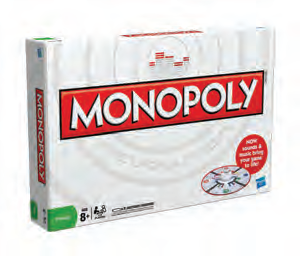 staid old board with sound effects and credit cards instead of cash. Buying houses you can’t afford in real life is fun! History’s happiest accident—the Slinky— has
staid old board with sound effects and credit cards instead of cash. Buying houses you can’t afford in real life is fun! History’s happiest accident—the Slinky— has
 returned to the family staircase in a 14- karat, gold-plated-brass 55th Anniversary Edition ($100 at Buy.com). According to legend, the discovery that the spring could “walk” was completely serendipitous. The rest is history, with more than 300 million sold and still counting. Another beloved blast from the past is the Rubiks Cube, now available in a glitzy high-tech Rubiks
returned to the family staircase in a 14- karat, gold-plated-brass 55th Anniversary Edition ($100 at Buy.com). According to legend, the discovery that the spring could “walk” was completely serendipitous. The rest is history, with more than 300 million sold and still counting. Another beloved blast from the past is the Rubiks Cube, now available in a glitzy high-tech Rubiks TouchCube version (on amazon.com for about $70). Nostalgia is also available in book form. The Official Preppy Handbook, that iconic, tongue-in-cheek treatise on the WASP-y culture of the 1980s, finally has its longa waited sequel. One of the original authors has taken another satirical look at the “new old guard” in True Prep: It’s a Whole New World.
TouchCube version (on amazon.com for about $70). Nostalgia is also available in book form. The Official Preppy Handbook, that iconic, tongue-in-cheek treatise on the WASP-y culture of the 1980s, finally has its longa waited sequel. One of the original authors has taken another satirical look at the “new old guard” in True Prep: It’s a Whole New World. 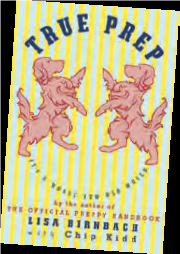 Buy it in hardcover at your local brick-and-mortar bookseller, or go for the preppier Kindle or iPad editions.
Buy it in hardcover at your local brick-and-mortar bookseller, or go for the preppier Kindle or iPad editions.
CHRISTMAS PRESENT An unfortunate reality of being a self-indulgent grown-up is that fitness and  exercise equipment often migrates onto our holiday wish lists. If you think walking (or even running) is for wimps—and can put off that new car purchase for another year—then you might want to trade in your treadmill for a Treadwall, a motorless rotating climbing wall that moves by body weight alone. The good news is you are never more than 1-2 feet off the floor. The bad news is that this will set you back about $10,000 (a KidWall version is less). Check it out at uniquefit1.com or call around to some climber-friendly gyms. If work intrudes on your workout, then consider equipping your home office with a Gaiam BalanceBall Chair (on Amazon.com for about $80).
exercise equipment often migrates onto our holiday wish lists. If you think walking (or even running) is for wimps—and can put off that new car purchase for another year—then you might want to trade in your treadmill for a Treadwall, a motorless rotating climbing wall that moves by body weight alone. The good news is you are never more than 1-2 feet off the floor. The bad news is that this will set you back about $10,000 (a KidWall version is less). Check it out at uniquefit1.com or call around to some climber-friendly gyms. If work intrudes on your workout, then consider equipping your home office with a Gaiam BalanceBall Chair (on Amazon.com for about $80).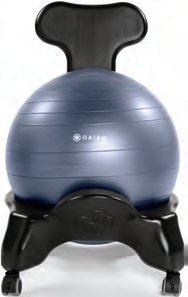 Chiropractically engineered, the chair continues working those core muscles even if you sit at your desk for hours. You’re basically buying the chair’s framework; the rest is BYOB (Bring Your Own Ball). It’s the same balance ball you use in your workout routines. Need to exercise on the road? You’ll have no more excuses away from home thanks to the Tumi Travel Fitness Trainer. It’s equipped with a pedometer, heart rate monitor, stopwatch, MP3 player and FM radio. Look for it at the Tumi store in the Short Hills Mall (or online at tumi.com) for about $165. Masochism comes in myriad forms, not all of which involve calorie burning workouts. Golf leaps to mind. Feeling the
Chiropractically engineered, the chair continues working those core muscles even if you sit at your desk for hours. You’re basically buying the chair’s framework; the rest is BYOB (Bring Your Own Ball). It’s the same balance ball you use in your workout routines. Need to exercise on the road? You’ll have no more excuses away from home thanks to the Tumi Travel Fitness Trainer. It’s equipped with a pedometer, heart rate monitor, stopwatch, MP3 player and FM radio. Look for it at the Tumi store in the Short Hills Mall (or online at tumi.com) for about $165. Masochism comes in myriad forms, not all of which involve calorie burning workouts. Golf leaps to mind. Feeling the  burn in this sport mostly happens between the ears. If greens are what get you blue, then consider the Laser Alignment Putting Trainer, which uses a laser beam to tell you when your putt is perfect— before you even touch the ball. Look for it online at hammacher.com for $329.95.
burn in this sport mostly happens between the ears. If greens are what get you blue, then consider the Laser Alignment Putting Trainer, which uses a laser beam to tell you when your putt is perfect— before you even touch the ball. Look for it online at hammacher.com for $329.95.
CHRISTMAS FUTURE If racing ahead of the pack gets you in the holiday spirit, then  you’ll be happy to hear that the toys of tomorrow are here today. For instance, you can actually carry around a computer in a pen with the LiveScribe Echo Smartpen. It captures everything you hear, write or say and delivers it with just a tap of the pen ($170 for 4GB and $200 for
you’ll be happy to hear that the toys of tomorrow are here today. For instance, you can actually carry around a computer in a pen with the LiveScribe Echo Smartpen. It captures everything you hear, write or say and delivers it with just a tap of the pen ($170 for 4GB and $200 for  8 GB versions at livescribe.com; also at Target). Or treat yourself to a Gyration Air Mouse, which controls apps on your computer, TV or DVD player with a wave of your hand ($70 and up at amazon.com or compusa.com). Gadget gals are turning cartwheels over the latest Flip Video Cams.
8 GB versions at livescribe.com; also at Target). Or treat yourself to a Gyration Air Mouse, which controls apps on your computer, TV or DVD player with a wave of your hand ($70 and up at amazon.com or compusa.com). Gadget gals are turning cartwheels over the latest Flip Video Cams.
 Their fetching case artwork belies their impressive HD video capabilities, with up to two hours of record time ($150 to $230). Best to go direct to theflip.com, where you can even upload your own photo for a personalized one-of-a-kind camera. If your final wish for 2010 (or final wish, period) is to careen down a snow-covered slope at 70 mph, then you’ll want to invest in an Airboard. Think of these Swiss-engineered inflatables as really Felixible Flyers. Popular for years in Europe, the Airboard has just begun appearing on American mountainsides. You may want to rent before you buy (they sell for $200 to $630 at airboard.com), and probably review your insurance policy. If your thrill-seeking tends to be a bit less public, then the Spy Net Secret Mission Video Watch may be more your speed. It’s a 21st Century take on those old decoder rings buried at the bottom of cereal boxes. It can audio record for 3 hours, video record for 20 minutes, and take still photos with a snake cam that lets you see around corners ($50 at jakks.com and also carried by Kmart).
Their fetching case artwork belies their impressive HD video capabilities, with up to two hours of record time ($150 to $230). Best to go direct to theflip.com, where you can even upload your own photo for a personalized one-of-a-kind camera. If your final wish for 2010 (or final wish, period) is to careen down a snow-covered slope at 70 mph, then you’ll want to invest in an Airboard. Think of these Swiss-engineered inflatables as really Felixible Flyers. Popular for years in Europe, the Airboard has just begun appearing on American mountainsides. You may want to rent before you buy (they sell for $200 to $630 at airboard.com), and probably review your insurance policy. If your thrill-seeking tends to be a bit less public, then the Spy Net Secret Mission Video Watch may be more your speed. It’s a 21st Century take on those old decoder rings buried at the bottom of cereal boxes. It can audio record for 3 hours, video record for 20 minutes, and take still photos with a snake cam that lets you see around corners ($50 at jakks.com and also carried by Kmart).

Editor’s Note: Chris Gibbs is the brains behind EDGE’s “It’s A Gift” section. She’s been waiting all year to do this story!


 Most experts agree that there are four cornerstones to a successful marriage. 1. Trust. 2. Honesty. 3. Unexpressed anger. 4. No sports junk on the walls. Many a man has tested rule #4 only to see that framed jersey or signed photo, without warning, donated to a local charity auction. Like a game of Jumanji, the priceless
Most experts agree that there are four cornerstones to a successful marriage. 1. Trust. 2. Honesty. 3. Unexpressed anger. 4. No sports junk on the walls. Many a man has tested rule #4 only to see that framed jersey or signed photo, without warning, donated to a local charity auction. Like a game of Jumanji, the priceless  heirloom insidiously then works its way into another home, where it initiates marital chaos all over again. Bill Crouse is the exception that proves rule #4. One of the world’s leading authorities on Art Deco posters, his collection may be the best ever assembled. When Crouse purchases a sports poster, it’s invariably a jaw-dropper. In these pages we present a handful of sporting selections from the renowned Crouse Collection. You won’t find these masterpieces at your suburban gala or fundraiser. You will see them in museums and galleries in Europe and the U.S. (including right now at the Guggenheim’s Chaos and Classicism exhibit). If you want to buy them at auction, be prepared to spend somewhere in the mid-six figures!
heirloom insidiously then works its way into another home, where it initiates marital chaos all over again. Bill Crouse is the exception that proves rule #4. One of the world’s leading authorities on Art Deco posters, his collection may be the best ever assembled. When Crouse purchases a sports poster, it’s invariably a jaw-dropper. In these pages we present a handful of sporting selections from the renowned Crouse Collection. You won’t find these masterpieces at your suburban gala or fundraiser. You will see them in museums and galleries in Europe and the U.S. (including right now at the Guggenheim’s Chaos and Classicism exhibit). If you want to buy them at auction, be prepared to spend somewhere in the mid-six figures! Art Deco posterists. In this advertisement for a 1934 tournament, Caroselli used this technique—along with an airbrushed black “cocoon”—to capture the energy of a layup.
Art Deco posterists. In this advertisement for a 1934 tournament, Caroselli used this technique—along with an airbrushed black “cocoon”—to capture the energy of a layup.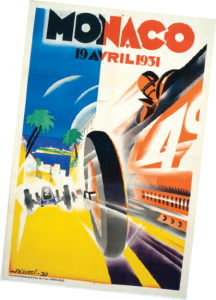 Monaco/19 Avril 1931 • Robert Falcucci (1900-1989) This rarest of Monaco GP posters—possibly the only example in private hands—shows a Mercedes SSK in hot pursuit of a red Bugatti. Falcucci’s use of white streaks running the length of the racer, concentric arcs of white behind to convey the rush of the wind, and the bright palette of red, yellow and blue give this streamlined design great panache. A multitalented painter, decorator and illustrator, Falcucci received his formal training in Paris and served as the historical painter for the French Army.
Monaco/19 Avril 1931 • Robert Falcucci (1900-1989) This rarest of Monaco GP posters—possibly the only example in private hands—shows a Mercedes SSK in hot pursuit of a red Bugatti. Falcucci’s use of white streaks running the length of the racer, concentric arcs of white behind to convey the rush of the wind, and the bright palette of red, yellow and blue give this streamlined design great panache. A multitalented painter, decorator and illustrator, Falcucci received his formal training in Paris and served as the historical painter for the French Army.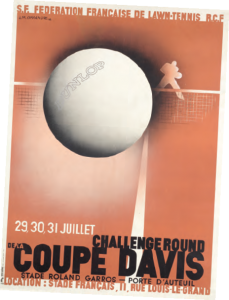
 attention by placing them in the path of an oncoming shot at net. The use of geometry and dynamic perspective in this extraordinarily rare poster— as well as the ease with which the design’s elements are assembled—are superb examples of what made Cassandre the most important Art Deco figure in the history of advertising posters.
attention by placing them in the path of an oncoming shot at net. The use of geometry and dynamic perspective in this extraordinarily rare poster— as well as the ease with which the design’s elements are assembled—are superb examples of what made Cassandre the most important Art Deco figure in the history of advertising posters. III Olympic Winter Games • Witold Gordon (1885-1968) Gordon left no doubt in this iconic poster where the center of the
III Olympic Winter Games • Witold Gordon (1885-1968) Gordon left no doubt in this iconic poster where the center of the 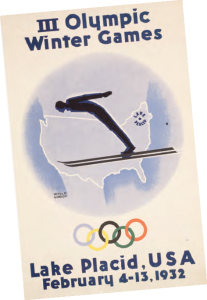 sports universe would be in February of 1932: Lake Placid. These Winter Games—the first held in North America—were opened by New York Governor (and soon-to-be U.S. President) Franklin Roosevelt. Gordon also designed the grand murals at Radio City Music Hall and the 1939 World’s Fair.”
sports universe would be in February of 1932: Lake Placid. These Winter Games—the first held in North America—were opened by New York Governor (and soon-to-be U.S. President) Franklin Roosevelt. Gordon also designed the grand murals at Radio City Music Hall and the 1939 World’s Fair.”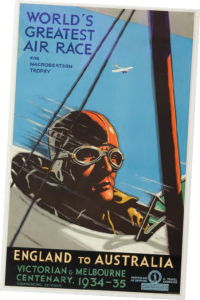 1er Campeonato Mondial de Football • Guillermo Laborde (1886-1940) This poster for the inaugural World Cup is the Holy Grail collectible for soccer fans. Laborde conveys the action and athleticism of the sport with
1er Campeonato Mondial de Football • Guillermo Laborde (1886-1940) This poster for the inaugural World Cup is the Holy Grail collectible for soccer fans. Laborde conveys the action and athleticism of the sport with  just a few linear elements. An acclaimed South American artist and sculptor, he agreed to judge the poster submissions for the 1930 World Cup. Later, Laborde resigned from the panel and submitted two of his own—which came in first and third.
just a few linear elements. An acclaimed South American artist and sculptor, he agreed to judge the poster submissions for the 1930 World Cup. Later, Laborde resigned from the panel and submitted two of his own—which came in first and third.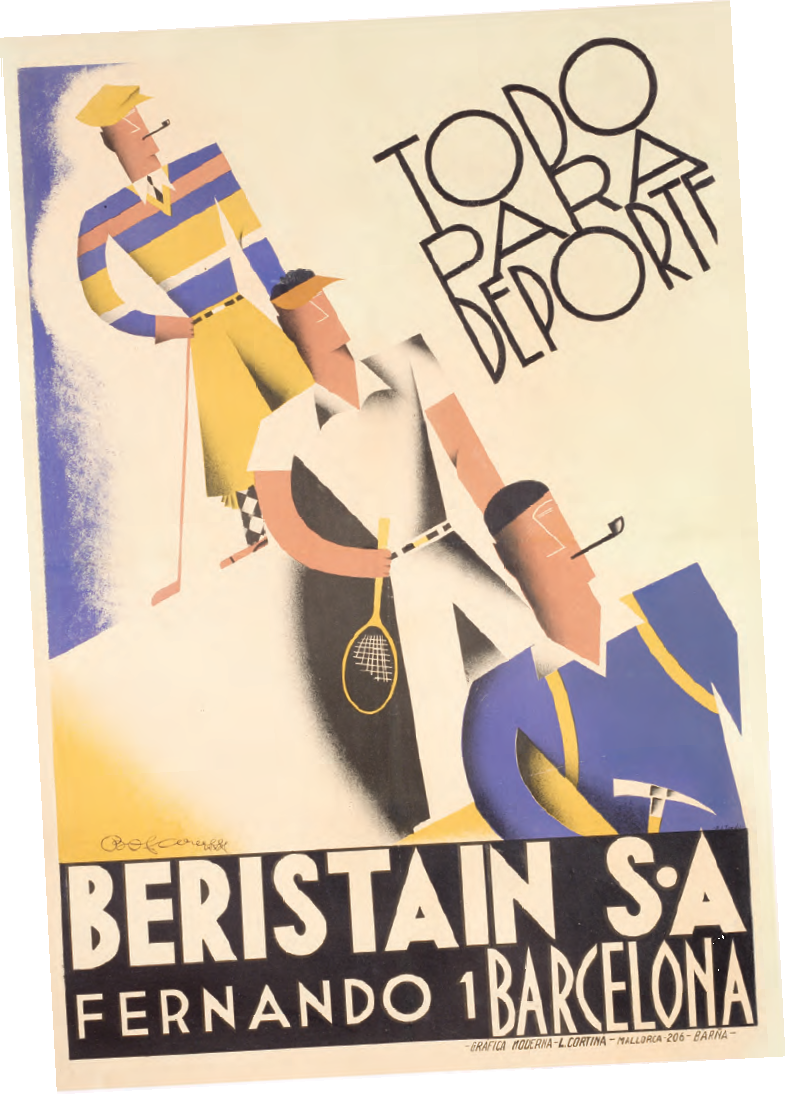
 Silk, the fabric of kings and emperors—of nobility, popes and czars—has always signified wealth, prestige and luxury. Always? Probably, that is if you agree that a commodity cherished since 5000 B.C. merits such a term of longevity. Pharaohs dating back at least that far have been disentombed, their royal cadavers worshipfully swathed in silk. In ancient Rome, the wearing of silk was forbidden the ordinary citizen. Only members of the imperial family could appear in public wearing it. In Europe, by the 15th century, the French city of Lyon was calling itself the Silk Capital of the World.
Silk, the fabric of kings and emperors—of nobility, popes and czars—has always signified wealth, prestige and luxury. Always? Probably, that is if you agree that a commodity cherished since 5000 B.C. merits such a term of longevity. Pharaohs dating back at least that far have been disentombed, their royal cadavers worshipfully swathed in silk. In ancient Rome, the wearing of silk was forbidden the ordinary citizen. Only members of the imperial family could appear in public wearing it. In Europe, by the 15th century, the French city of Lyon was calling itself the Silk Capital of the World. How justified was that claim? Well, when that bit of braggadocio first surfaced, it’s more than possible that China, Korea, India and who knows what other kingdoms might well have challenged Lyon for the title. But today, in the rarefied world of haute couture, Lyon with its silken boast, is right on the money. A city of half a million, Lyon is situated between two rivers: the fast-flowing Rhone and the gently flowing Soane, both passing the city, southbound to the Mediterranean. Of its long and proud history, suffice it to say that it once was the capital of Gaul and often visited by more than one Emperor. In the last two or three years, the traboules of Lyon, those 18th-century covered passageways that crisscross the silk workers’ district, have seen a virtual stampede of designers and couturiers. They fly in from Milan, New York, Tokyo and all points in between. Their names read like a celestial roll call in the paradise of high fashion. Dior, Lanvin, Chanel, Versace, Vera Wang. They come intent on securing exclusivity, or the nearest thing thereto, on the exquisite fabrics that spill forth from the looms of Lyon. Silk, which never ever was out, is now more than ever in. From the silk-wrapped heels of shoes by Dries van Noten to the extravagant ruffles of Lanvin’s evening wear, the word is SILK. Contradicting everything that fashion pundits know about trend, style and fad, silk retains its hold on elegance even while it also successfully teams up with jeans, beach wear and the most casual of the casual. Not possible! Yet true. Lyon owes much of its silky prestige to François I, the first Renaissance king to grace the French throne. A major patron of the arts and a great admirer of Italian style and elegance, he was determined to see France surpass Italy in all artistic endeavors. To that end he persuaded the great Leonardo da Vinci to quit his native Tuscany and come to live in France. Leonardo packed up bag and baggage, tucking into his luggage his favorite opus, “La Gioconda” (aka Mona Lisa). After he died in 1519, cradled in the arms of a weeping King François, that masterpiece became French property. Today it hangs in the Louvre in Paris where, as a touristic attraction, it ranks second only to the Eiffel Tower. Apart from luring Leonardo and his Mona Lisa to France, Francois I also determined that the weavers of Lyon, specialists i
How justified was that claim? Well, when that bit of braggadocio first surfaced, it’s more than possible that China, Korea, India and who knows what other kingdoms might well have challenged Lyon for the title. But today, in the rarefied world of haute couture, Lyon with its silken boast, is right on the money. A city of half a million, Lyon is situated between two rivers: the fast-flowing Rhone and the gently flowing Soane, both passing the city, southbound to the Mediterranean. Of its long and proud history, suffice it to say that it once was the capital of Gaul and often visited by more than one Emperor. In the last two or three years, the traboules of Lyon, those 18th-century covered passageways that crisscross the silk workers’ district, have seen a virtual stampede of designers and couturiers. They fly in from Milan, New York, Tokyo and all points in between. Their names read like a celestial roll call in the paradise of high fashion. Dior, Lanvin, Chanel, Versace, Vera Wang. They come intent on securing exclusivity, or the nearest thing thereto, on the exquisite fabrics that spill forth from the looms of Lyon. Silk, which never ever was out, is now more than ever in. From the silk-wrapped heels of shoes by Dries van Noten to the extravagant ruffles of Lanvin’s evening wear, the word is SILK. Contradicting everything that fashion pundits know about trend, style and fad, silk retains its hold on elegance even while it also successfully teams up with jeans, beach wear and the most casual of the casual. Not possible! Yet true. Lyon owes much of its silky prestige to François I, the first Renaissance king to grace the French throne. A major patron of the arts and a great admirer of Italian style and elegance, he was determined to see France surpass Italy in all artistic endeavors. To that end he persuaded the great Leonardo da Vinci to quit his native Tuscany and come to live in France. Leonardo packed up bag and baggage, tucking into his luggage his favorite opus, “La Gioconda” (aka Mona Lisa). After he died in 1519, cradled in the arms of a weeping King François, that masterpiece became French property. Today it hangs in the Louvre in Paris where, as a touristic attraction, it ranks second only to the Eiffel Tower. Apart from luring Leonardo and his Mona Lisa to France, Francois I also determined that the weavers of Lyon, specialists i n the secrets of silk-making, should be elevated to the front ranks of French commerce. To accomplish his objective he opened the royal purse strings to attract Europe’s finest weavers. Before his reign ended in 1547, Lyon was acknowledged as the primary source for the finest silks the world had ever seen. For the next 300 years, the weavers of Lyon thrived, lodged in high-ceilinged buildings, designed to accommodate their huge hand-operated looms. Today the looms of Lyon are high-tech marvels, controlled by computers. But in the section known as Croix Rouge, a handful of the ancient looms remain. To the delight of tourists, the weavers perform their ancient rites, still turning out priceless yardage. Few who watch the process escape a visit to the adjoining gift shops, all amply stocked with scarves, shawls, ties, skirts, shirts, purses, bedding, all of course of priceless silk. “I use silk in every one of my collections,” says Andrew Gn, the Singapore-born, Paris-based designer whose highfashion creations are carried by Bergdorf Goodman. “Silk drapes much better than anything else…and the contact of silk with skin is irreplaceable.” In his forthcoming Spring/Summer 2011 collection, Gn uses a magnificent triple-silk crepe, specially woven for his atelier. As he puts it, “Silk translates colors much better; it makes them extremely rich.” His clientele consists in large part of individuals seeking one of- a-kind creations which can be worn in the sure knowledge that her choice will not be replicated. (It’s an assurance that doesn’t come at bargain prices!) Monsieur Gn’s clientele, which includes a healthy smattering of royalty and easily-recognized names from the world of diplomats and heads of state, professes fierce loyalty to their designer of choice. Simply put, “He’s a genius,” was the gratuitous observation by an obviously satisfied client. For Andre Claude Canova, a passion for the silks of Lyon began more than a quarter of a century ago. Today he designs his own collection, which includes the most exquisite silk scarves—some of which encompass as many as 15 or 20 different colors, an achievement unequalled by any other designer. His studio at 26 Quai St.Vincent in the heart of Lyon is an old Carthusian residence, its entrance a handsome horseshoe-shaped Renaissance staircase. Favored buyers are received in its superbly furnished salons, the walls lined with…what else? Pure silk. The ambience is unmistakably Old World but the scarves, vests, pillows and jackets are on the very cutting edge. His own special design of scarf suspenders created a minor tsunami in the world of fashion when they first appeared. Supermodel Jerry Hall was so enchanted with them that she ordered 20 pairs. Princess Caroline of Monaco is frequently photographed in them and when the G-7 convened in Lyon, Bill and Hillary were delighted to be presented with a selection of Canova scarf-suspenders. An undoubted original, Andre Claude-Canova, when asked the source of his creative inspirations, replied, “Travel, history, nature.” He went on, “It can be a sunset in Tuscany, the masks of the Maasai, the silky pearl shades of a Maharajah’s robes, or the jewels of the Taj Mahal…” But the one constant in all of his creations is silk, woven in an unmatched panoply of colors. The distinction of being the oldest silk factory in Lyon belongs to Prelle et Cie, which has been in continuous operation since 1752 and is owned today by direct descendents of its founders. Apart from its stylish contemporary output of scarves, ties, shawls and other pieces, Prelle has proven invaluable in the rarefied world of authentic restoration of palaces and castles, historical houses and public places. It counts among its restorative masterpieces the authentic recreation of the silk brocades used in the Royal Bedchamber of the Sun King, Louis XIV, at Versailles, the draperies and upholstered pieces at Biltmore in North Carolina and at Ash Lawn, the ancestral home in Virginia of James Monroe. Such historical replication of two- and three-hundred-yearold fabrics is possible thanks in part to the exquisite workmanship of the Prelle artisans, and in part to the company’s scrupulously maintained archives, which date back four centuries.
n the secrets of silk-making, should be elevated to the front ranks of French commerce. To accomplish his objective he opened the royal purse strings to attract Europe’s finest weavers. Before his reign ended in 1547, Lyon was acknowledged as the primary source for the finest silks the world had ever seen. For the next 300 years, the weavers of Lyon thrived, lodged in high-ceilinged buildings, designed to accommodate their huge hand-operated looms. Today the looms of Lyon are high-tech marvels, controlled by computers. But in the section known as Croix Rouge, a handful of the ancient looms remain. To the delight of tourists, the weavers perform their ancient rites, still turning out priceless yardage. Few who watch the process escape a visit to the adjoining gift shops, all amply stocked with scarves, shawls, ties, skirts, shirts, purses, bedding, all of course of priceless silk. “I use silk in every one of my collections,” says Andrew Gn, the Singapore-born, Paris-based designer whose highfashion creations are carried by Bergdorf Goodman. “Silk drapes much better than anything else…and the contact of silk with skin is irreplaceable.” In his forthcoming Spring/Summer 2011 collection, Gn uses a magnificent triple-silk crepe, specially woven for his atelier. As he puts it, “Silk translates colors much better; it makes them extremely rich.” His clientele consists in large part of individuals seeking one of- a-kind creations which can be worn in the sure knowledge that her choice will not be replicated. (It’s an assurance that doesn’t come at bargain prices!) Monsieur Gn’s clientele, which includes a healthy smattering of royalty and easily-recognized names from the world of diplomats and heads of state, professes fierce loyalty to their designer of choice. Simply put, “He’s a genius,” was the gratuitous observation by an obviously satisfied client. For Andre Claude Canova, a passion for the silks of Lyon began more than a quarter of a century ago. Today he designs his own collection, which includes the most exquisite silk scarves—some of which encompass as many as 15 or 20 different colors, an achievement unequalled by any other designer. His studio at 26 Quai St.Vincent in the heart of Lyon is an old Carthusian residence, its entrance a handsome horseshoe-shaped Renaissance staircase. Favored buyers are received in its superbly furnished salons, the walls lined with…what else? Pure silk. The ambience is unmistakably Old World but the scarves, vests, pillows and jackets are on the very cutting edge. His own special design of scarf suspenders created a minor tsunami in the world of fashion when they first appeared. Supermodel Jerry Hall was so enchanted with them that she ordered 20 pairs. Princess Caroline of Monaco is frequently photographed in them and when the G-7 convened in Lyon, Bill and Hillary were delighted to be presented with a selection of Canova scarf-suspenders. An undoubted original, Andre Claude-Canova, when asked the source of his creative inspirations, replied, “Travel, history, nature.” He went on, “It can be a sunset in Tuscany, the masks of the Maasai, the silky pearl shades of a Maharajah’s robes, or the jewels of the Taj Mahal…” But the one constant in all of his creations is silk, woven in an unmatched panoply of colors. The distinction of being the oldest silk factory in Lyon belongs to Prelle et Cie, which has been in continuous operation since 1752 and is owned today by direct descendents of its founders. Apart from its stylish contemporary output of scarves, ties, shawls and other pieces, Prelle has proven invaluable in the rarefied world of authentic restoration of palaces and castles, historical houses and public places. It counts among its restorative masterpieces the authentic recreation of the silk brocades used in the Royal Bedchamber of the Sun King, Louis XIV, at Versailles, the draperies and upholstered pieces at Biltmore in North Carolina and at Ash Lawn, the ancestral home in Virginia of James Monroe. Such historical replication of two- and three-hundred-yearold fabrics is possible thanks in part to the exquisite workmanship of the Prelle artisans, and in part to the company’s scrupulously maintained archives, which date back four centuries.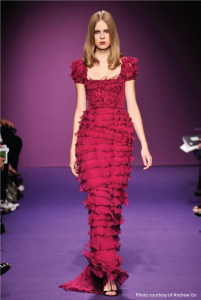 Patterns, hand-drawn in quill and ink, with color samples provided in watercolor paints—their intricate designs sketched in painstaking detail and selected for use in palaces, stately homes, public halls—were recorded and filed. Thus modern-day restorers are able to see exactly what designs and what colors were used in specific venues centuries past. No other silk weaving establishment anywhere in the world can claim as much. In addition to its French premises, Prelle also maintains a showroom in New York at 43 E. 10th Street. Apart from its gilded salons and showrooms frequented by the world’s top designers, Lyon has more than its fair share of stylish boutiques. All along the Rue de la Republique (incidentally, the longest pedestrian street in France), the very latest trends are fetchingly displayed in shop windows. Come early December, Lyon celebrates the Festival of Lights. For one glorious week the town is lighted throughout the night. Music seems to pour from every doorway; mimes, jugglers and troupes of musicians are everywhere. It’s as if the whole city was tripping out on some incredible potion. The restaurants—1,000 of them at last count—do a landslide business, for gastronomy in Lyon is a source of huge civic pride. It’s not for nothing that Lyon is often called the “best-fed” city in France. When I repeated the epitaph to a Lyonnais, he quickly put me straight: “The best-fed city not in France, but in Europe!” So much for local modesty. Then again, it’s no mere coincidence that Paul Bocuse, the high priest of French gastronomy, chooses to live in Lyon, where he presides over two restaurants. A world famous chef who actually cooks? It sounds ordinary enough, but in the tippy-top layers of prize-winning, globally-acclaimed chefs, it’s rare enough to elicit expressions of wonder from fellow chefs. A final word of advice. Don’t journey to the city in search of bargains. It’s doubtful that Lyon even knows the meaning of the word. But if it’s quality you seek, if it’s the full value of every Euro spent, then quite definitely, Lyon may be just the city for you.
Patterns, hand-drawn in quill and ink, with color samples provided in watercolor paints—their intricate designs sketched in painstaking detail and selected for use in palaces, stately homes, public halls—were recorded and filed. Thus modern-day restorers are able to see exactly what designs and what colors were used in specific venues centuries past. No other silk weaving establishment anywhere in the world can claim as much. In addition to its French premises, Prelle also maintains a showroom in New York at 43 E. 10th Street. Apart from its gilded salons and showrooms frequented by the world’s top designers, Lyon has more than its fair share of stylish boutiques. All along the Rue de la Republique (incidentally, the longest pedestrian street in France), the very latest trends are fetchingly displayed in shop windows. Come early December, Lyon celebrates the Festival of Lights. For one glorious week the town is lighted throughout the night. Music seems to pour from every doorway; mimes, jugglers and troupes of musicians are everywhere. It’s as if the whole city was tripping out on some incredible potion. The restaurants—1,000 of them at last count—do a landslide business, for gastronomy in Lyon is a source of huge civic pride. It’s not for nothing that Lyon is often called the “best-fed” city in France. When I repeated the epitaph to a Lyonnais, he quickly put me straight: “The best-fed city not in France, but in Europe!” So much for local modesty. Then again, it’s no mere coincidence that Paul Bocuse, the high priest of French gastronomy, chooses to live in Lyon, where he presides over two restaurants. A world famous chef who actually cooks? It sounds ordinary enough, but in the tippy-top layers of prize-winning, globally-acclaimed chefs, it’s rare enough to elicit expressions of wonder from fellow chefs. A final word of advice. Don’t journey to the city in search of bargains. It’s doubtful that Lyon even knows the meaning of the word. But if it’s quality you seek, if it’s the full value of every Euro spent, then quite definitely, Lyon may be just the city for you.
 If you’re planning to make 2011 the year you lose weight and get fit, join the club: Studies show these are the most common resolutions people make come January 1st. Good luck to you; the grim reality is that most of the people who start the year off wanting to slim down don’t end up succeeding. The same goes for other popular New Year’s vows—stop smoking, get out of debt, help others, etc., etc. etc. The bottom line is that we just aren’t wired to break habits overnight that we’ve developed over 10, 20 or 30 years. As individuals, human beings tend to value their individuality. As a species, we’re just plain stubborn. Some great minds have weighed in on this subject. The controversial author Anaïs Nin insisted she made no resolutions to curb her habits, because “the habit of making plans, of criticizing, sanctioning and molding my life, is too much of a daily event for me.” Sculptor Henry Moore preferred to “think in terms of the day’s resolutions, not the year’s.” Writer Oscar Wilde, whose list of questionable habits was practically endless, characterized resolutions as “checks that men draw on a bank where they have no account.” Comic Joey Adams’s favorite party toast was “May all your troubles last as long as your New Year’s resolutions.” Mark Twain evaluated New Year’s resolutions with a single word: Humbug. Given this overwhelming preponderance of intellectual evidence, what chance do we mere mortals have to drop a few pounds and elevate our fitness? According to Michelle Ali, a registered dietician at Trinitas Regional Medical Center, there are 10 things we can do to improve the odds:
If you’re planning to make 2011 the year you lose weight and get fit, join the club: Studies show these are the most common resolutions people make come January 1st. Good luck to you; the grim reality is that most of the people who start the year off wanting to slim down don’t end up succeeding. The same goes for other popular New Year’s vows—stop smoking, get out of debt, help others, etc., etc. etc. The bottom line is that we just aren’t wired to break habits overnight that we’ve developed over 10, 20 or 30 years. As individuals, human beings tend to value their individuality. As a species, we’re just plain stubborn. Some great minds have weighed in on this subject. The controversial author Anaïs Nin insisted she made no resolutions to curb her habits, because “the habit of making plans, of criticizing, sanctioning and molding my life, is too much of a daily event for me.” Sculptor Henry Moore preferred to “think in terms of the day’s resolutions, not the year’s.” Writer Oscar Wilde, whose list of questionable habits was practically endless, characterized resolutions as “checks that men draw on a bank where they have no account.” Comic Joey Adams’s favorite party toast was “May all your troubles last as long as your New Year’s resolutions.” Mark Twain evaluated New Year’s resolutions with a single word: Humbug. Given this overwhelming preponderance of intellectual evidence, what chance do we mere mortals have to drop a few pounds and elevate our fitness? According to Michelle Ali, a registered dietician at Trinitas Regional Medical Center, there are 10 things we can do to improve the odds: 

 A golden lotus gracefully opens its ethereal petals, revealing diamonds dancing delicately on its pistils and stamens. It is an alchemist’s dream. No clunky piece of
A golden lotus gracefully opens its ethereal petals, revealing diamonds dancing delicately on its pistils and stamens. It is an alchemist’s dream. No clunky piece of 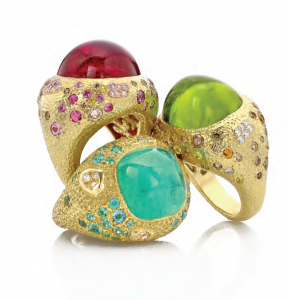 jewelry, this luminescent brooch blossoms with timeless design, creativity, and craftsmanship. So often we go treasure hunting in New York, yet so rarely do we unearth a real treasure. In this case the map couldn’t be marked more clearly. Forego 47th Street. Skip breakfast at Tiffany’s. Wander up Madison Ave. past Chopard and Chanel, and turn east on East 70th Street. Proceed to a cluster of brownstones close to Lexington Avenue. There, tucked behind a gentle garden sits a boite of a jewelry store called Mish New York. For years, my Upper East Side girlfriends have talked in hushed, reverent tones about Mish. They swoon over Mish’s chalcedony and diamond earrings, sigh at the sight of the topaz, gold and diamond pagoda pin and quietly covet the gold Chinese charm bracelet. This eponymous boutique also houses a select array of stunning jewel-encrusted rings, bracelets, necklaces and cufflinks created by Mish Tworkowski, a boyish, friendly former senior VP of Jewelry at Sotheby’s. A New Jersey native, Mish graduated from Rutgers with a double degree in Art History and Business Administration—both of which, no doubt, contributed to his accomplishments as a taste-making jewelry designer and successful entrepreneur. Along with the discerning artistic eye and business acumen, Mish’s interest in jewelry design, its process and art, grew out of an early exposure to all aspects of jewelry making. “A family friend owned a jewelry studio and factory where I would hang out watching the craftsmen at work—creating molds, casting, soldering and polishing silver and gold, and setting stones. It was a fun and amazing place.” Mish explains. “So through osmosis and access to the workshop at a young age, I got to the point where I could make drawings and then
jewelry, this luminescent brooch blossoms with timeless design, creativity, and craftsmanship. So often we go treasure hunting in New York, yet so rarely do we unearth a real treasure. In this case the map couldn’t be marked more clearly. Forego 47th Street. Skip breakfast at Tiffany’s. Wander up Madison Ave. past Chopard and Chanel, and turn east on East 70th Street. Proceed to a cluster of brownstones close to Lexington Avenue. There, tucked behind a gentle garden sits a boite of a jewelry store called Mish New York. For years, my Upper East Side girlfriends have talked in hushed, reverent tones about Mish. They swoon over Mish’s chalcedony and diamond earrings, sigh at the sight of the topaz, gold and diamond pagoda pin and quietly covet the gold Chinese charm bracelet. This eponymous boutique also houses a select array of stunning jewel-encrusted rings, bracelets, necklaces and cufflinks created by Mish Tworkowski, a boyish, friendly former senior VP of Jewelry at Sotheby’s. A New Jersey native, Mish graduated from Rutgers with a double degree in Art History and Business Administration—both of which, no doubt, contributed to his accomplishments as a taste-making jewelry designer and successful entrepreneur. Along with the discerning artistic eye and business acumen, Mish’s interest in jewelry design, its process and art, grew out of an early exposure to all aspects of jewelry making. “A family friend owned a jewelry studio and factory where I would hang out watching the craftsmen at work—creating molds, casting, soldering and polishing silver and gold, and setting stones. It was a fun and amazing place.” Mish explains. “So through osmosis and access to the workshop at a young age, I got to the point where I could make drawings and then 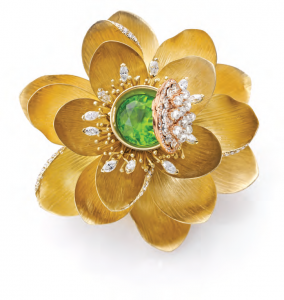 think about how to convert a drawing into a piece of jewelry through, say, the ‘lost-wax’ process.” After college came a 15-year stint at Sotheby’s, which included overseeing the estate sales of Diana Vreeland and Jacqueline Kennedy Onassis. Soon Mish started creating his own line of jewelry. His early business “began organically, as many of my clients at Sotheby’s became friends and were interested in my designs.” He began selling his jewelry on the side with his Sotheby’s boss’s blessings. A self-described “happy workaholic,” Mish threw himself into his dream of opening a shop in 2001. His apprenticeship at Sotheby’s gave Mish some definite thoughts on the subjects of taste and style. To him, they are closely linked. “If you define tasteful and stylish, tasteful could be negative, implying that someone is boring, maybe too solemn or safe in her dress,” he says. “Tasteful and good taste are different. Good taste is always appropriate. Good taste is finely edited, never anything superfluous. Stylish, or having style, is someone who is willing to take a little risk. The little surprise that it gives is always wonderful. It might make you smile. It might make you think, ‘Wow, that person is creative and original.’ When someone is stylish, it is under the veil of appropriateness, there is a tastefulness, but with flair.” Nature is Mish’s primary muse. While at Wakaya, a client’s resort in Fiji, Mish was so blown away by the vibrant colors of sea life that—despite being a self-professed “waterphobic”— donned scuba gear and ventured out to the coral reef. “The colors were awe-inspiring,” Mish recalls. “Huge cobalt-blue starfish, yellow, pink, purple and salmon coral, fish of all colors. I went there to relax, but from the moment I stepped on the island, I was designing jewelry non-stop.”
think about how to convert a drawing into a piece of jewelry through, say, the ‘lost-wax’ process.” After college came a 15-year stint at Sotheby’s, which included overseeing the estate sales of Diana Vreeland and Jacqueline Kennedy Onassis. Soon Mish started creating his own line of jewelry. His early business “began organically, as many of my clients at Sotheby’s became friends and were interested in my designs.” He began selling his jewelry on the side with his Sotheby’s boss’s blessings. A self-described “happy workaholic,” Mish threw himself into his dream of opening a shop in 2001. His apprenticeship at Sotheby’s gave Mish some definite thoughts on the subjects of taste and style. To him, they are closely linked. “If you define tasteful and stylish, tasteful could be negative, implying that someone is boring, maybe too solemn or safe in her dress,” he says. “Tasteful and good taste are different. Good taste is always appropriate. Good taste is finely edited, never anything superfluous. Stylish, or having style, is someone who is willing to take a little risk. The little surprise that it gives is always wonderful. It might make you smile. It might make you think, ‘Wow, that person is creative and original.’ When someone is stylish, it is under the veil of appropriateness, there is a tastefulness, but with flair.” Nature is Mish’s primary muse. While at Wakaya, a client’s resort in Fiji, Mish was so blown away by the vibrant colors of sea life that—despite being a self-professed “waterphobic”— donned scuba gear and ventured out to the coral reef. “The colors were awe-inspiring,” Mish recalls. “Huge cobalt-blue starfish, yellow, pink, purple and salmon coral, fish of all colors. I went there to relax, but from the moment I stepped on the island, I was designing jewelry non-stop.” 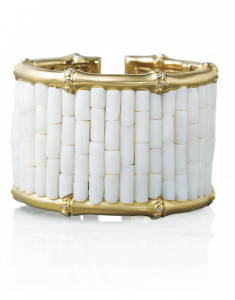 Mish has a devoted following of chic New Yorkers. His wide smile and signature bowties reveal a man confident in his own style, who effortlessly puts people at ease. I recently walked into the cheery shop to find a film crew interviewing Mish for a BIG birthday montage for a regular customer. I heard Mish thank her, teasing that without her enthusiastic patronage, he would “never have been able to buy Karl Lagerfeld’s Paris apartment!” When a museum curator friend heard I was researching this story, she emailed me pictures of her Mish treasures— the “go-to” orbiting pearl earrings, the aquamarine necklace, the Henderson brooch Mish designed for her, which she described as a “stunner on a navy suit jacket…the subtlety of colors shows the eye of the artist.” Even online at 72 dpi, she looked great. “What I love about this jewelry,” she wrote, “is his masterly way of mixing colors, keeping it all fresh and not serious-looking (even if the prices are serious). It’s easy to wear.” Mish enjoys collaborating with his customers and being inspired by their lives and interests. His playful wit emerged when designing cuff links and tuxedo studs for a client’s husband’s 50th birthday. The husband collected cars and especially loved his Aston-Martin. Mish made studs, using photos the wife took, that were replicas of the wheels (replete with gemstone hubcaps). He backed the cuff links with miniature gold versions of Aston-Martin tire treads. “What is special about coming to someone like me is that I’m not wholesaling, but dealing one-on-one with the client with a defined style,” Mish explains. “Many jewelers have globalized, so that you can buy their jewelry in any city or country and so can your friends. If you want to buy my designs or find something unique that none of your friends have, you have to come to my store.” In a world where so much is mass-produced, impersonal and brazenly marketed, it is rare to come across a business that thrives on artistry, workmanship and word of mouth. We sometimes forget that, in matters of the heart, a gulf still separates the ordinary from the extraordinary. Mish is a reminder of just how wide that gulf can be. EDGE
Mish has a devoted following of chic New Yorkers. His wide smile and signature bowties reveal a man confident in his own style, who effortlessly puts people at ease. I recently walked into the cheery shop to find a film crew interviewing Mish for a BIG birthday montage for a regular customer. I heard Mish thank her, teasing that without her enthusiastic patronage, he would “never have been able to buy Karl Lagerfeld’s Paris apartment!” When a museum curator friend heard I was researching this story, she emailed me pictures of her Mish treasures— the “go-to” orbiting pearl earrings, the aquamarine necklace, the Henderson brooch Mish designed for her, which she described as a “stunner on a navy suit jacket…the subtlety of colors shows the eye of the artist.” Even online at 72 dpi, she looked great. “What I love about this jewelry,” she wrote, “is his masterly way of mixing colors, keeping it all fresh and not serious-looking (even if the prices are serious). It’s easy to wear.” Mish enjoys collaborating with his customers and being inspired by their lives and interests. His playful wit emerged when designing cuff links and tuxedo studs for a client’s husband’s 50th birthday. The husband collected cars and especially loved his Aston-Martin. Mish made studs, using photos the wife took, that were replicas of the wheels (replete with gemstone hubcaps). He backed the cuff links with miniature gold versions of Aston-Martin tire treads. “What is special about coming to someone like me is that I’m not wholesaling, but dealing one-on-one with the client with a defined style,” Mish explains. “Many jewelers have globalized, so that you can buy their jewelry in any city or country and so can your friends. If you want to buy my designs or find something unique that none of your friends have, you have to come to my store.” In a world where so much is mass-produced, impersonal and brazenly marketed, it is rare to come across a business that thrives on artistry, workmanship and word of mouth. We sometimes forget that, in matters of the heart, a gulf still separates the ordinary from the extraordinary. Mish is a reminder of just how wide that gulf can be. EDGE 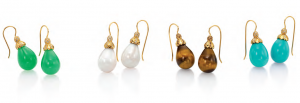

 checking. Boardwalk Empire chronicles the highlights and lowlights of the corrupt politicians who came to rule Atlantic City when the town’s sole purpose was providing a good time to its visitors (legally or not). Nucky Thompson, played by Steve Buscemi, is based on Nucky Johnson, the second of three bosses to lead the political machine that dominated city politics, funded by payoffs from bars, brothels, and bootlegging. The real-life Nucky ruled the town for three decades starting in the years prior to World War I. When the author’s manuscript (originally dubbed “Nucky’s Town”) found its way into the hands of John Bryans at Plexus nearly a decade ago, the publisher knew it would sell based on the company’s success with similar regional projects. Johnson always believed it could be more, despite fruitless trips to Hollywood to pitch the story as a feature film or documentary. Fortunately, Johnson did catch the attention of an agent, and in 2006 Bryans received an e-mail from an HBO television executive who was salivating for the rights to a book revolving around shocking backdoor politics, explosive violence, and fatal power struggles. The HBO series debuted on September 19th, 2010, starring Buscemi, Michael Pitt and Kelly Macdonald. The show features the creative talents of Terence Winter, writer on The Sopranos, and Mark Wahlberg as producer; Martin Scorsese directed the first episode. Winter also penned the foreword for the new edition of the book. As a sitting judge, the author has backed away from interviews publicizing the book or the HBO series. However, according to Bryans, upon initial publication, Boardwalk Empire sold roughly 10,000 copies. Thanks to the buzz created by HBO, another 10,000 flew off the shelves. An order for another 85,000 copies, updated to be a tie-in edition, followed. The book concerns itself with a much broader sweep of material than the more narrowly focused series, which, as Bryans points out, focuses on “sex, violence, and swearing.” That being said, the seedy underbelly of Atlantic City is fully exposed in Johnson’s book—often with the aid of stunningly blunt first-person accounts. As one mob connected interview subject observed, “If the people who came to town had wanted Bible readings, we’d have given ’em that…they wanted booze, broads and gambling, so that’s what we gave ’em.” Regarding the HBO series, Bryans has liked what he sees on the small screen. “The show helps you realize that Nucky is a complex, fascinating character, and one you love to hate,” he says. “It’s nice to see that people are open to shades of gray.” “If you delve into the history of any major city in New Jersey,” Bryans maintains, “you’ll probably find the basis for a book. I think Boardwalk Empire makes everyone start thinking about the birth of their own hometown.” EDGE
checking. Boardwalk Empire chronicles the highlights and lowlights of the corrupt politicians who came to rule Atlantic City when the town’s sole purpose was providing a good time to its visitors (legally or not). Nucky Thompson, played by Steve Buscemi, is based on Nucky Johnson, the second of three bosses to lead the political machine that dominated city politics, funded by payoffs from bars, brothels, and bootlegging. The real-life Nucky ruled the town for three decades starting in the years prior to World War I. When the author’s manuscript (originally dubbed “Nucky’s Town”) found its way into the hands of John Bryans at Plexus nearly a decade ago, the publisher knew it would sell based on the company’s success with similar regional projects. Johnson always believed it could be more, despite fruitless trips to Hollywood to pitch the story as a feature film or documentary. Fortunately, Johnson did catch the attention of an agent, and in 2006 Bryans received an e-mail from an HBO television executive who was salivating for the rights to a book revolving around shocking backdoor politics, explosive violence, and fatal power struggles. The HBO series debuted on September 19th, 2010, starring Buscemi, Michael Pitt and Kelly Macdonald. The show features the creative talents of Terence Winter, writer on The Sopranos, and Mark Wahlberg as producer; Martin Scorsese directed the first episode. Winter also penned the foreword for the new edition of the book. As a sitting judge, the author has backed away from interviews publicizing the book or the HBO series. However, according to Bryans, upon initial publication, Boardwalk Empire sold roughly 10,000 copies. Thanks to the buzz created by HBO, another 10,000 flew off the shelves. An order for another 85,000 copies, updated to be a tie-in edition, followed. The book concerns itself with a much broader sweep of material than the more narrowly focused series, which, as Bryans points out, focuses on “sex, violence, and swearing.” That being said, the seedy underbelly of Atlantic City is fully exposed in Johnson’s book—often with the aid of stunningly blunt first-person accounts. As one mob connected interview subject observed, “If the people who came to town had wanted Bible readings, we’d have given ’em that…they wanted booze, broads and gambling, so that’s what we gave ’em.” Regarding the HBO series, Bryans has liked what he sees on the small screen. “The show helps you realize that Nucky is a complex, fascinating character, and one you love to hate,” he says. “It’s nice to see that people are open to shades of gray.” “If you delve into the history of any major city in New Jersey,” Bryans maintains, “you’ll probably find the basis for a book. I think Boardwalk Empire makes everyone start thinking about the birth of their own hometown.” EDGE 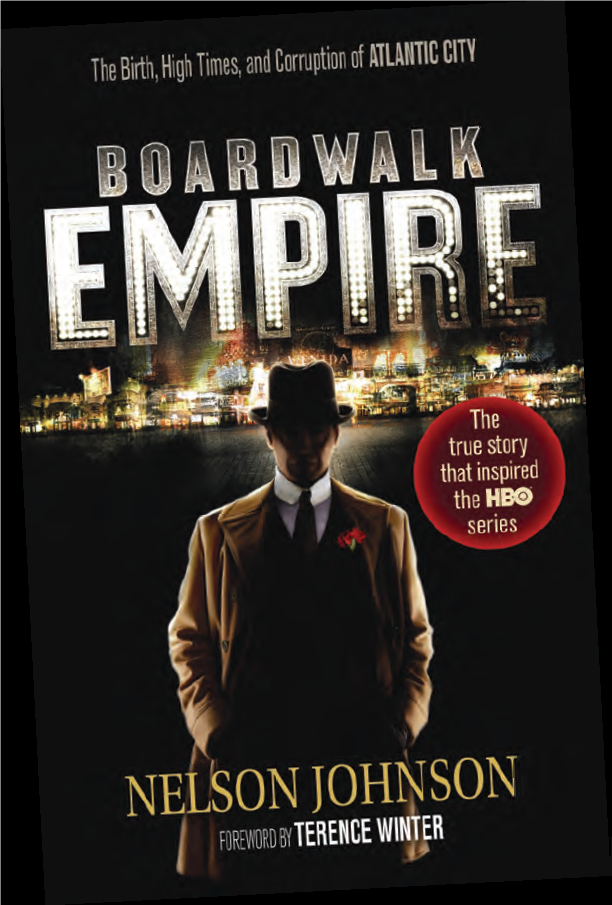
 the mini-bouts of depression and anger that sometimes accompany this season are very real. The holiday blues can grip even the happiest, most well-adjusted of us with little or no warning. Understanding where these feelings come from, as well as your options for addressing them, can go a long way toward making it to January with your sanity intact. According to Dr. Rodger Goddard, who has served as Chief Psychologist at Trinitas Regional Medical Center for more than two decades, stress is almost always the trigger. And holiday stress can come from many sources. “At the end of the year, during the holidays, we reflect on our lives,” he explains. “When we reflect, we can get nervous about many things. For instance, many of us now face intense financial stress due to the state of the economy. This kind of reflection often leads us to dwell on our shortcomings and what we don’t have, rather than our accomplishments and the miracle of just being alive.” Dealing with relatives can just compound the situation. Tension between different family members, dwelling on past hurts or injustices, rivalries and jealousies can bring old wounds back to the surface. In this environment, little things—such as where to eat, what to eat and who sits where—can become incredibly stressful and suck the joy out of what should be pleasant reconnections and reunions. “On top of this,” Dr. Goddard adds, “we often eat and drink too much. The result is body discomfort, which contributes to distressing emotions.” The media can play a leading role in feelings of depression and anger. Movies, music, television shows and commercials all make the holidays out to be a magical time of happiness and perfection. To feel otherwise just feels wrong. “We live in reality, not a movie,” says Dr. Goddard. “Holidays cramp our schedule—overloading us with shopping, socializing, preparations and party-going. The holiday season has become hyper-commercialized, giving us the message that love is shown through material gift-giving. Under these conditions, we can feel that what we give and what we get are being constantly evaluated—which leads to even more stress.”
the mini-bouts of depression and anger that sometimes accompany this season are very real. The holiday blues can grip even the happiest, most well-adjusted of us with little or no warning. Understanding where these feelings come from, as well as your options for addressing them, can go a long way toward making it to January with your sanity intact. According to Dr. Rodger Goddard, who has served as Chief Psychologist at Trinitas Regional Medical Center for more than two decades, stress is almost always the trigger. And holiday stress can come from many sources. “At the end of the year, during the holidays, we reflect on our lives,” he explains. “When we reflect, we can get nervous about many things. For instance, many of us now face intense financial stress due to the state of the economy. This kind of reflection often leads us to dwell on our shortcomings and what we don’t have, rather than our accomplishments and the miracle of just being alive.” Dealing with relatives can just compound the situation. Tension between different family members, dwelling on past hurts or injustices, rivalries and jealousies can bring old wounds back to the surface. In this environment, little things—such as where to eat, what to eat and who sits where—can become incredibly stressful and suck the joy out of what should be pleasant reconnections and reunions. “On top of this,” Dr. Goddard adds, “we often eat and drink too much. The result is body discomfort, which contributes to distressing emotions.” The media can play a leading role in feelings of depression and anger. Movies, music, television shows and commercials all make the holidays out to be a magical time of happiness and perfection. To feel otherwise just feels wrong. “We live in reality, not a movie,” says Dr. Goddard. “Holidays cramp our schedule—overloading us with shopping, socializing, preparations and party-going. The holiday season has become hyper-commercialized, giving us the message that love is shown through material gift-giving. Under these conditions, we can feel that what we give and what we get are being constantly evaluated—which leads to even more stress.”
 According to Dr. Goddard, your anti-stress strategy should look something like this:
According to Dr. Goddard, your anti-stress strategy should look something like this:

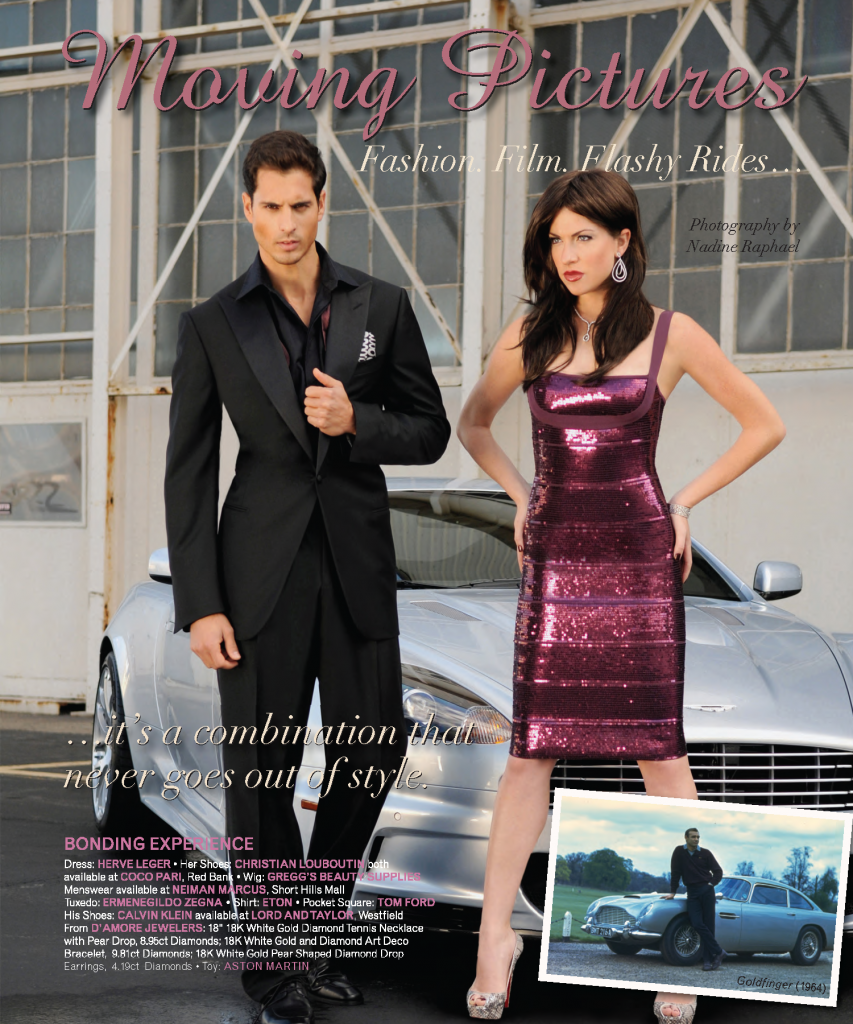




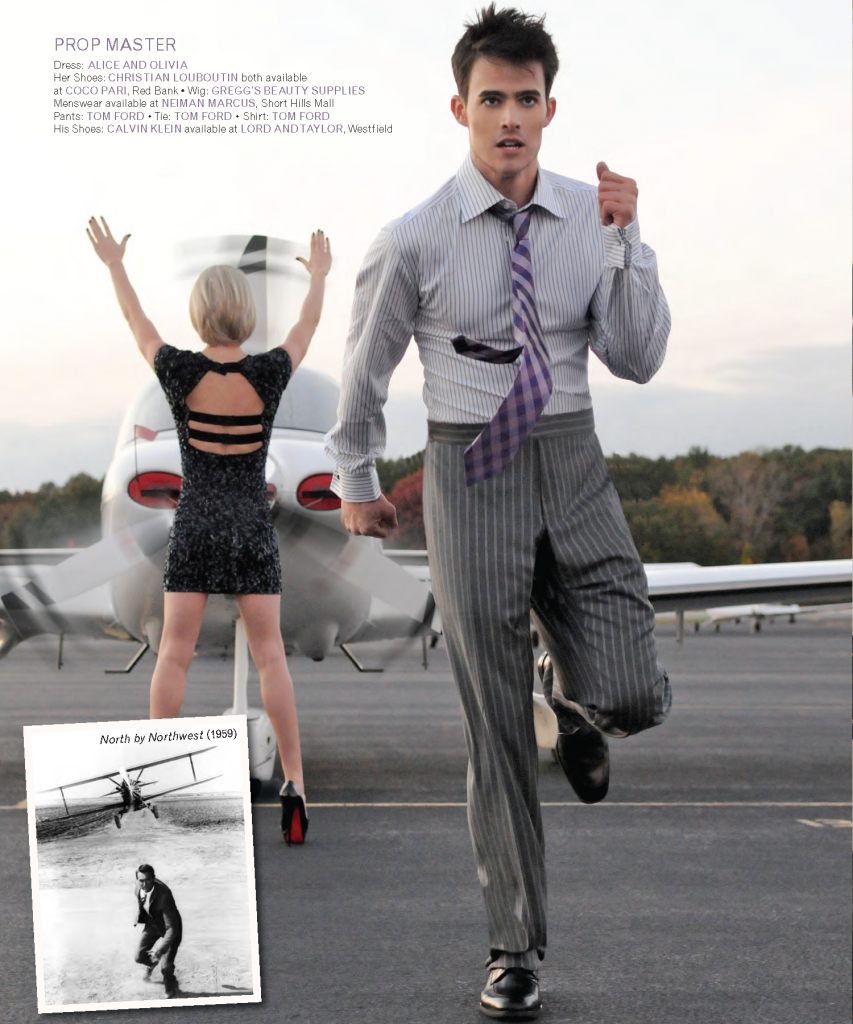
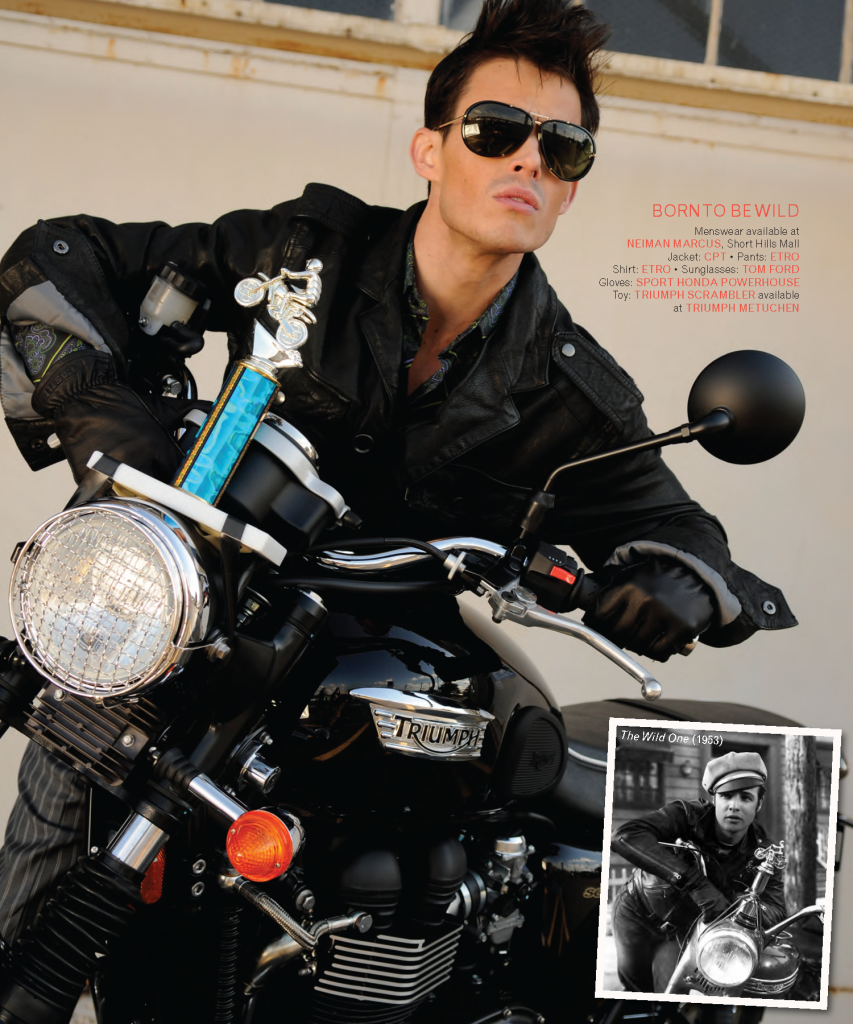

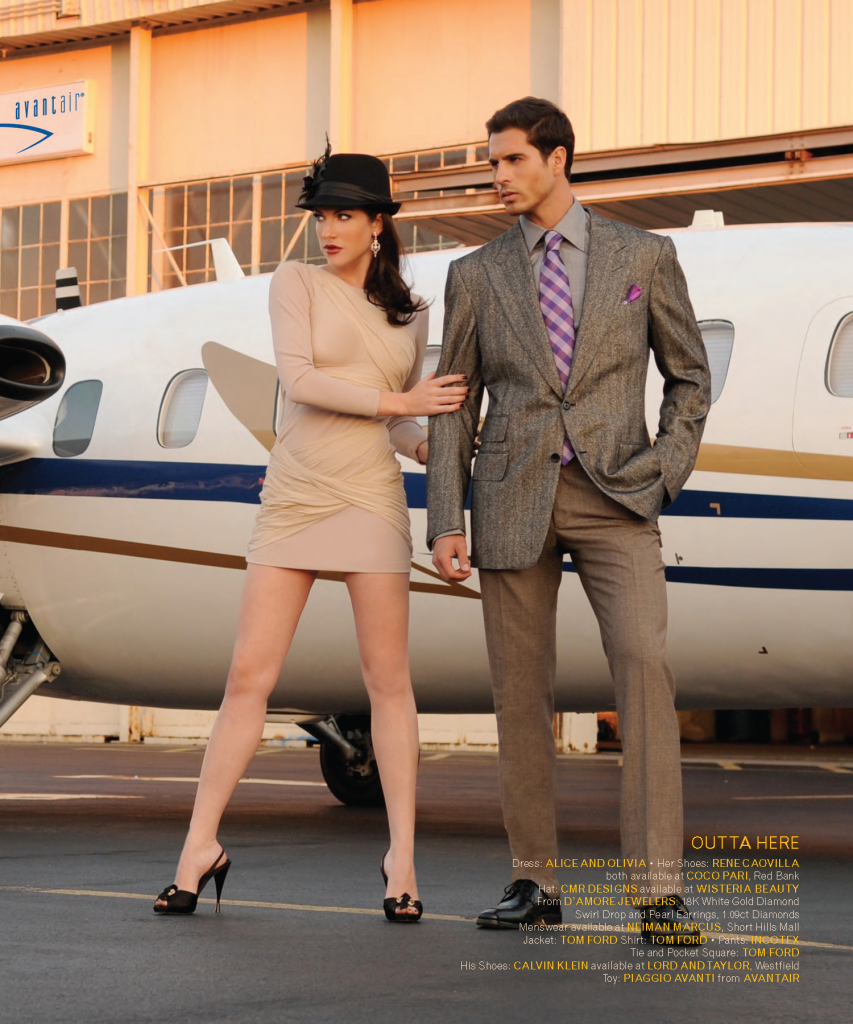
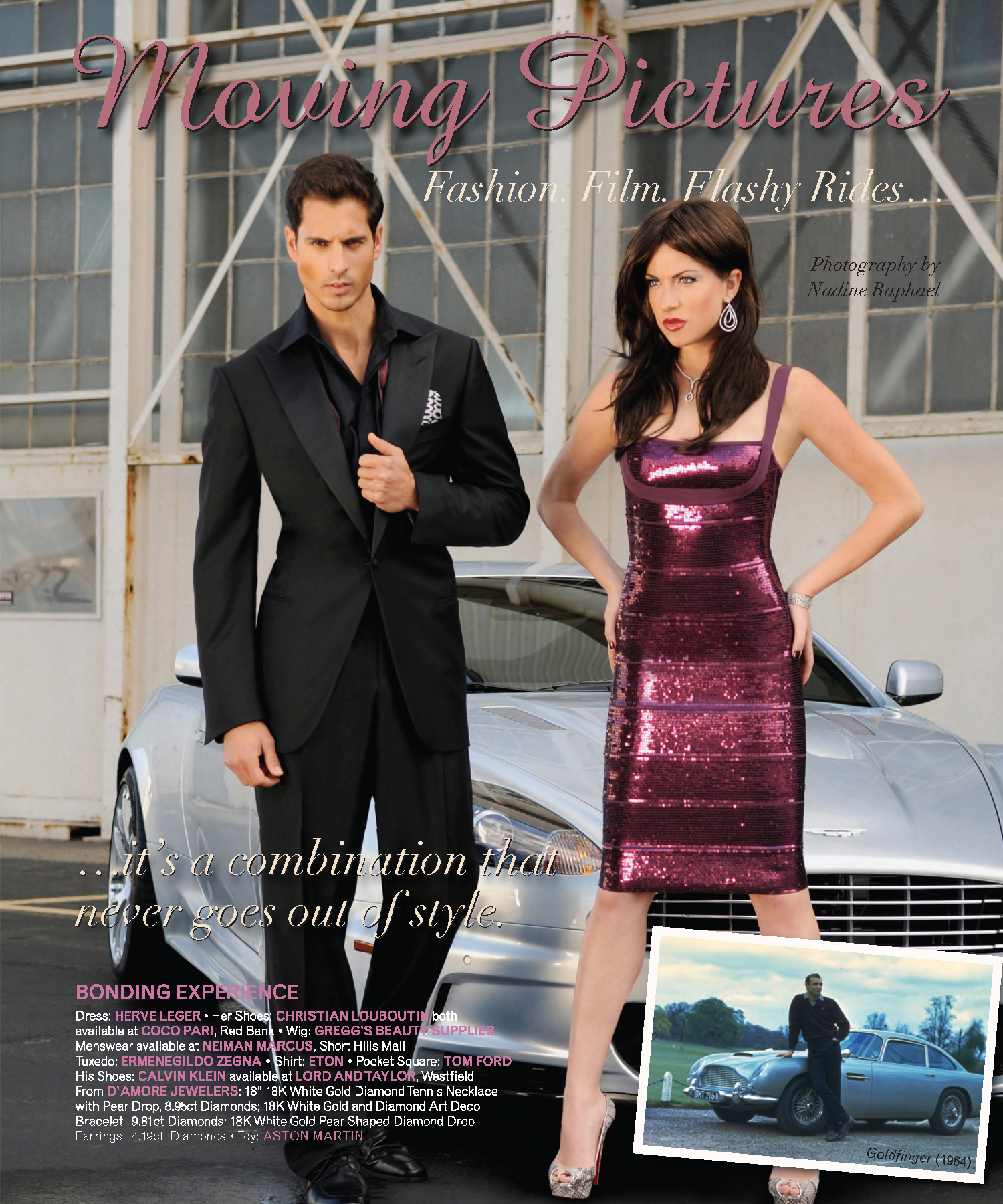
 That’s fine if your goal is to own an undistinguished sofa-sized oil. But what if you want fine art—the kind that will brighten your life and fatten your bottom line? The answer may be as close as your local gallery. For those who believe you have to cross the Hudson to find investment-grade art, this idea may go against the grain. But the fact is that building a relationship with a gallery (or galleries) here in the Garden State can yield a far greater return—not just in terms of value and quality, but in so many other ways. This applies to the seasoned collector as well as the novice. In fact, if you’re like so many New Jerseyans, the thought of opening your checkbook in a local art gallery is nothing short of terrifying. First things first. Let’s wrap our minds around the reasons New Jerseyans don’t buy art. Above all there is the intimidation factor. Most people are afraid they’ll be taken to the cleaners by an unscrupulous gallery owner.
That’s fine if your goal is to own an undistinguished sofa-sized oil. But what if you want fine art—the kind that will brighten your life and fatten your bottom line? The answer may be as close as your local gallery. For those who believe you have to cross the Hudson to find investment-grade art, this idea may go against the grain. But the fact is that building a relationship with a gallery (or galleries) here in the Garden State can yield a far greater return—not just in terms of value and quality, but in so many other ways. This applies to the seasoned collector as well as the novice. In fact, if you’re like so many New Jerseyans, the thought of opening your checkbook in a local art gallery is nothing short of terrifying. First things first. Let’s wrap our minds around the reasons New Jerseyans don’t buy art. Above all there is the intimidation factor. Most people are afraid they’ll be taken to the cleaners by an unscrupulous gallery owner. Second, they are nervous that their friends will make fun of a purchase that is different and modern, or simply out of character. Feeding this double-barreled paranoia is the fact that—particularly in the case of an abstract piece—one cannot specifically define the level of talent and technical skill involved in producing modern art. And on top of these very legitimate fears is the great, big elephant in the room: Why, when New York City is so close, would anyone buy art in New Jersey in the first place? Permit me to deal with this last objection first. Galleries here in New Jersey are indeed different than most galleries in the city. That is to say that they are friendly and approachable. If you think about it, it makes complete sense. Gallery owners are where they are, and do what they do, because they love and appreciate art. If they were in this business to make a killing, I hate to say it but they would be in Manhattan. What else does New Jersey have to offer art buyers that the city doesn’t? Well, there is a lot of first-rate talent that, for one reason or another, is only shown on this side of the Hudson.
Second, they are nervous that their friends will make fun of a purchase that is different and modern, or simply out of character. Feeding this double-barreled paranoia is the fact that—particularly in the case of an abstract piece—one cannot specifically define the level of talent and technical skill involved in producing modern art. And on top of these very legitimate fears is the great, big elephant in the room: Why, when New York City is so close, would anyone buy art in New Jersey in the first place? Permit me to deal with this last objection first. Galleries here in New Jersey are indeed different than most galleries in the city. That is to say that they are friendly and approachable. If you think about it, it makes complete sense. Gallery owners are where they are, and do what they do, because they love and appreciate art. If they were in this business to make a killing, I hate to say it but they would be in Manhattan. What else does New Jersey have to offer art buyers that the city doesn’t? Well, there is a lot of first-rate talent that, for one reason or another, is only shown on this side of the Hudson. 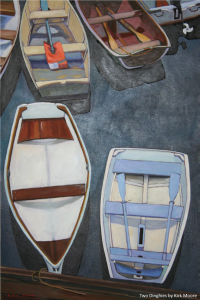 There is no comparison in terms of service. Try walking into a gallery on West Broadway or Madison Avenue and asking the owner to drive out to your place in Westfield for a consultation. That thud is the sound of his jaw hitting the floor. A gallery owner in or around your town, on the other hand, will likely welcome this opportunity. New Jersey art dealers are genuinely interested in the people who live around them, and cultivating relationships that extend beyond the buying and selling of art. They are part of the fabric of the community. Connecting with a local gallery also happens to be a superb way of adding texture to your social life. Once you’re “on the list” you’ll be invited to opening receptions whenever a new artist is featured. How often do you get to mix and mingle with new people who just happen to share a common interest? The majority of people attending gallery openings are like you—they want to know more about art and the people who buy it. (By the way, a free wine-and-cheese gathering is a wonderful springboard to dinner, a movie, or whatever else you’ve planned for an evening out.) Okay, so what about the financial side of the gallery relationship? Now more than ever, as we balance the merits of saving and spending, it is important to know what you get for your money when you purchase a work of art. Whether the price tag is several hundred or several thousand, dealers who live and work nearby are unlikely to “rip off” customers; they have reputations to uphold. If you happen to be one of the fortunate few who have five or six figures to invest in art, a good dealer will have solid connections to galleries that can point you in the right direction (and more importantly, steer you clear of the wrong direction). Either way, if your appreciation of art is tied to its potential appreciation, make that clear to the gallery owners you deal with.
There is no comparison in terms of service. Try walking into a gallery on West Broadway or Madison Avenue and asking the owner to drive out to your place in Westfield for a consultation. That thud is the sound of his jaw hitting the floor. A gallery owner in or around your town, on the other hand, will likely welcome this opportunity. New Jersey art dealers are genuinely interested in the people who live around them, and cultivating relationships that extend beyond the buying and selling of art. They are part of the fabric of the community. Connecting with a local gallery also happens to be a superb way of adding texture to your social life. Once you’re “on the list” you’ll be invited to opening receptions whenever a new artist is featured. How often do you get to mix and mingle with new people who just happen to share a common interest? The majority of people attending gallery openings are like you—they want to know more about art and the people who buy it. (By the way, a free wine-and-cheese gathering is a wonderful springboard to dinner, a movie, or whatever else you’ve planned for an evening out.) Okay, so what about the financial side of the gallery relationship? Now more than ever, as we balance the merits of saving and spending, it is important to know what you get for your money when you purchase a work of art. Whether the price tag is several hundred or several thousand, dealers who live and work nearby are unlikely to “rip off” customers; they have reputations to uphold. If you happen to be one of the fortunate few who have five or six figures to invest in art, a good dealer will have solid connections to galleries that can point you in the right direction (and more importantly, steer you clear of the wrong direction). Either way, if your appreciation of art is tied to its potential appreciation, make that clear to the gallery owners you deal with. They will help you assess potential purchases (or emerging artists) with that goal in mind. Another advantage to buying in New Jersey—besides the good feeling that comes with supporting a local business— is that gallery owners here may be much more likely to work a deal that fits your finances. Their overhead is lower than in the city, which may translate into wiggle room when you whip out the checkbook. Finally, keep in mind as you shop or budget for fine art that you are buying something that could turn out to be a family treasure. Art is timeless. Art is priceless. Unlike a sofa or granite countertop, it does not depreciate the moment it walks through your front door. If you’ve chosen wisely, in fact, it could appreciate dramatically. And as it moves from your home to your children’s, and then to your children’s children’s and beyond, it serves as a link between the generations. In the meantime, this investment will enhance your quality of life every time you fix your gaze upon it. Indeed, as Pablo Picasso once observed, art “washes away from the soul the dust of everyday life.” Amen to that. Some other art icons have also had a thing or two to say on the subject. Jackson Pollock famously noted that every good painter paints what he is. Rembrandt suggested practicing what you know to make clear what now you do not know. Believe it or not, Michelangelo often insisted, I can actually draw. Clarity and simplicity enabled these great painters to create magnificently complex works of art. When it comes to buying art in the Garden State, a little clarity and simplicity also goes a long way. EDGE
They will help you assess potential purchases (or emerging artists) with that goal in mind. Another advantage to buying in New Jersey—besides the good feeling that comes with supporting a local business— is that gallery owners here may be much more likely to work a deal that fits your finances. Their overhead is lower than in the city, which may translate into wiggle room when you whip out the checkbook. Finally, keep in mind as you shop or budget for fine art that you are buying something that could turn out to be a family treasure. Art is timeless. Art is priceless. Unlike a sofa or granite countertop, it does not depreciate the moment it walks through your front door. If you’ve chosen wisely, in fact, it could appreciate dramatically. And as it moves from your home to your children’s, and then to your children’s children’s and beyond, it serves as a link between the generations. In the meantime, this investment will enhance your quality of life every time you fix your gaze upon it. Indeed, as Pablo Picasso once observed, art “washes away from the soul the dust of everyday life.” Amen to that. Some other art icons have also had a thing or two to say on the subject. Jackson Pollock famously noted that every good painter paints what he is. Rembrandt suggested practicing what you know to make clear what now you do not know. Believe it or not, Michelangelo often insisted, I can actually draw. Clarity and simplicity enabled these great painters to create magnificently complex works of art. When it comes to buying art in the Garden State, a little clarity and simplicity also goes a long way. EDGE 
 Seven forty-five on a Saturday night, and the show is about to begin. Regulars file into the corner storefront at Maplewood and Baker, settling into seats that almost seem assigned. There are nods of recognition, glances over to the fellow in charge, a sense of anticipation in not-sohushed exchanges. Corks pop. Wine glasses are filled and the floor crew at Arturo’s switches into high gear. At the rear of the intimate restaurant, chef/maestro Dan Richer already has warmed up his wood-burning oven by firing dozens and dozens of pizzas for the early-eating crowd. But right now, as the 8 o’clock hour approaches, he’s dispatching cups filled with husked cherries, also known as bush cherries. They’re nutty little fruits that look a bit like miniature tomatillos, but taste like nothing else on the planet. Peel back the papery skins, flick the fruit into your mouth and wonder how you’ll ever again eat another sugared peanut or mushy olive as a prelude to dinner. They’re the ideal starter for Richer’s unique show. It’s dinner theater, this ritualistic Saturday night minuet between chef and diner, a paean to all that’s locally grown and produced and catches the chef’s discerning eye. There’s no formal bill of fare on this night, just a procession of plates served forth with no fanfare and minimal explanation. It’s based on the trust Richer has built up between himself and his diners, folks who have warmed to the distinctive style of both the rustic, no-frills dining space and the man who delivers a spare, yet deeply satisfying dining experience. “Coppa, house-made,” is the way our server describes the next dish. He knows no embellishment is needed to sell diners on the veritable kaleidoscope made from cured pork shoulder and its fat, presented as delicate slices of salumi that appear air-brushed on the platter. Alone, or partnered with crusty, country bread, this coppa is pretty darn perfect. Actually, so is Arturo’s. Richer took over the old pizza joint in downtown Maplewood in early 2007 and re-made it to suit his dreams and palate. Pizzas are now of the modern age – that is to say, they go back in time to ovens fueled by wood, to crusts born of kneading and slow-rise techniques, to toppings that tilt toward Spartan, not extra-anything. A welledited selection of those thin-crust pizzas plus pastas are the order of the night five days a week, with Tuesdays turned over to a scaled-back tasting menu and Saturdays the destination-diner extravaganza. On that night, Richer goes strictly market and microseasonal. It’s completely, obsessively ingredient-driven in a good way. Ask about the olive oil, for instance, and you’ll be brought a bottle of the newest member of the Arturo’s Olive Oil Brigade, an unfiltered number from Puglia whose fruitiness makes already silky-sweet scallops even silkier and sweeter. These scallops are the star of Richer’s crudo, a bowl of dense and rich shellfish bathed in the Puglian oil
Seven forty-five on a Saturday night, and the show is about to begin. Regulars file into the corner storefront at Maplewood and Baker, settling into seats that almost seem assigned. There are nods of recognition, glances over to the fellow in charge, a sense of anticipation in not-sohushed exchanges. Corks pop. Wine glasses are filled and the floor crew at Arturo’s switches into high gear. At the rear of the intimate restaurant, chef/maestro Dan Richer already has warmed up his wood-burning oven by firing dozens and dozens of pizzas for the early-eating crowd. But right now, as the 8 o’clock hour approaches, he’s dispatching cups filled with husked cherries, also known as bush cherries. They’re nutty little fruits that look a bit like miniature tomatillos, but taste like nothing else on the planet. Peel back the papery skins, flick the fruit into your mouth and wonder how you’ll ever again eat another sugared peanut or mushy olive as a prelude to dinner. They’re the ideal starter for Richer’s unique show. It’s dinner theater, this ritualistic Saturday night minuet between chef and diner, a paean to all that’s locally grown and produced and catches the chef’s discerning eye. There’s no formal bill of fare on this night, just a procession of plates served forth with no fanfare and minimal explanation. It’s based on the trust Richer has built up between himself and his diners, folks who have warmed to the distinctive style of both the rustic, no-frills dining space and the man who delivers a spare, yet deeply satisfying dining experience. “Coppa, house-made,” is the way our server describes the next dish. He knows no embellishment is needed to sell diners on the veritable kaleidoscope made from cured pork shoulder and its fat, presented as delicate slices of salumi that appear air-brushed on the platter. Alone, or partnered with crusty, country bread, this coppa is pretty darn perfect. Actually, so is Arturo’s. Richer took over the old pizza joint in downtown Maplewood in early 2007 and re-made it to suit his dreams and palate. Pizzas are now of the modern age – that is to say, they go back in time to ovens fueled by wood, to crusts born of kneading and slow-rise techniques, to toppings that tilt toward Spartan, not extra-anything. A welledited selection of those thin-crust pizzas plus pastas are the order of the night five days a week, with Tuesdays turned over to a scaled-back tasting menu and Saturdays the destination-diner extravaganza. On that night, Richer goes strictly market and microseasonal. It’s completely, obsessively ingredient-driven in a good way. Ask about the olive oil, for instance, and you’ll be brought a bottle of the newest member of the Arturo’s Olive Oil Brigade, an unfiltered number from Puglia whose fruitiness makes already silky-sweet scallops even silkier and sweeter. These scallops are the star of Richer’s crudo, a bowl of dense and rich shellfish bathed in the Puglian oil 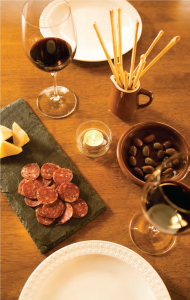 with needle-thin slivers of French breakfast radish that add color and bite to the raw-fish dish. There are a few twirls of baby greens—so tiny that they probably are better thought of as newborn greens—to add color and contrast, and that’s it. It’s gentle, it’s refined, it’s an exacting example of what this chef is trying to do: simplify, simplify, simplify. That’s his culinary style, and it’s both brave and smart. While others less secure in their métier, less confident of their skills, fuss and add a silly number of frills to a plate, Richer practices the art of the take-away. He pares down a dish to its fundamentals, letting his ingredients assume center stage. A salad of baby arugula, for instance, is accented by thin slices of peaches and flecks of shaved Parmigiano- Reggiano. That’s it. High-season tomatoes, both cheery Sun Golds and beefy San Marzanos, are chopped and set in a glass compote to be served only with a sprinkling of sea salt. The tomatoes’ own juices make it good to the last drop. Tagliolini, a thin-strand pasta, is too fresh, too creamy in taste and texture to need anything more than a handful of teeny cubes of zucchini and a little grated Parmigiano Reggiano. We all but bribed our server to admit to an infusion of cream or butter. No, we were told. Nothing but the fresh pasta, the zucchini, the Parmigiano-Reggiano. That’s what good pasta can do. And a good hunk of pork shank needs but a bed of earthy kale to keep it company. In northern states, it’s such an underappreciated partnership, anything pig and greens. In Richer’s hands, it could be the next big thing in Yankeeland. His whipped ricotta, served with raspberries and what possibly was a mirage of shaved dark chocolate, is precisely what dessert should be: neither overwhelmingly sweet nor baroque in scale. I would’ve had seconds had seconds been offered, however, since I’ve always dreamed of cheese and fruit being transformed into just this kind of finale. I left Arturo’s thinking that either I should 1) move to Maplewood or 2) convince Richer to take his show on the road to my hometown. I’ll further assess these options when I return to Arturo’s for the duck prosciutto, hazelnut-pear salad and pasta with wild boar ragu. For without a doubt, this food needs to be a regular part of my eating life. EDGE
with needle-thin slivers of French breakfast radish that add color and bite to the raw-fish dish. There are a few twirls of baby greens—so tiny that they probably are better thought of as newborn greens—to add color and contrast, and that’s it. It’s gentle, it’s refined, it’s an exacting example of what this chef is trying to do: simplify, simplify, simplify. That’s his culinary style, and it’s both brave and smart. While others less secure in their métier, less confident of their skills, fuss and add a silly number of frills to a plate, Richer practices the art of the take-away. He pares down a dish to its fundamentals, letting his ingredients assume center stage. A salad of baby arugula, for instance, is accented by thin slices of peaches and flecks of shaved Parmigiano- Reggiano. That’s it. High-season tomatoes, both cheery Sun Golds and beefy San Marzanos, are chopped and set in a glass compote to be served only with a sprinkling of sea salt. The tomatoes’ own juices make it good to the last drop. Tagliolini, a thin-strand pasta, is too fresh, too creamy in taste and texture to need anything more than a handful of teeny cubes of zucchini and a little grated Parmigiano Reggiano. We all but bribed our server to admit to an infusion of cream or butter. No, we were told. Nothing but the fresh pasta, the zucchini, the Parmigiano-Reggiano. That’s what good pasta can do. And a good hunk of pork shank needs but a bed of earthy kale to keep it company. In northern states, it’s such an underappreciated partnership, anything pig and greens. In Richer’s hands, it could be the next big thing in Yankeeland. His whipped ricotta, served with raspberries and what possibly was a mirage of shaved dark chocolate, is precisely what dessert should be: neither overwhelmingly sweet nor baroque in scale. I would’ve had seconds had seconds been offered, however, since I’ve always dreamed of cheese and fruit being transformed into just this kind of finale. I left Arturo’s thinking that either I should 1) move to Maplewood or 2) convince Richer to take his show on the road to my hometown. I’ll further assess these options when I return to Arturo’s for the duck prosciutto, hazelnut-pear salad and pasta with wild boar ragu. For without a doubt, this food needs to be a regular part of my eating life. EDGE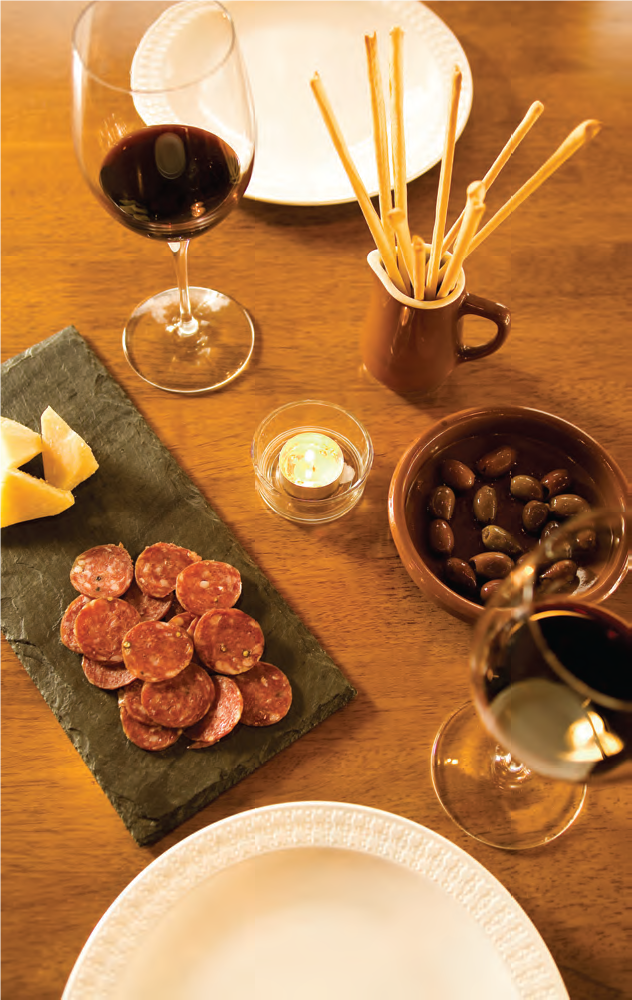


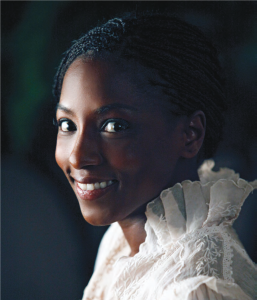 stay. The daughter of professional dancers, the Las Vegas born-and-bred Wesley took her show on the road—first to the University of Evansville as an undergrad and then to the Juilliard School in New York. Along the way, Wesley also studied at London’s Royal Academy of Dramatic Art. A plum role on Broadway in David Hare’s The Vertical Hour and the lead in the 2007 dance film How She Move earned her an audition for Alan Ball, who was casting the tricky role of Tara Thornton in True Blood. The depth she brought to the character not only won her the part, it has since made Wesley one of the most popular characters on television. EDGE Assignments Editor Zack Burgess took the actress back to Las Vegas to talk about her show business roots and inspirations, and to explore the imaginative and eclectic Rutina Look (his words, not hers). The ground rules for the interview? Only one “vampire question” allowed (our rules, not hers). Oh, the pressure! As usual, Zack saved the best for last.
stay. The daughter of professional dancers, the Las Vegas born-and-bred Wesley took her show on the road—first to the University of Evansville as an undergrad and then to the Juilliard School in New York. Along the way, Wesley also studied at London’s Royal Academy of Dramatic Art. A plum role on Broadway in David Hare’s The Vertical Hour and the lead in the 2007 dance film How She Move earned her an audition for Alan Ball, who was casting the tricky role of Tara Thornton in True Blood. The depth she brought to the character not only won her the part, it has since made Wesley one of the most popular characters on television. EDGE Assignments Editor Zack Burgess took the actress back to Las Vegas to talk about her show business roots and inspirations, and to explore the imaginative and eclectic Rutina Look (his words, not hers). The ground rules for the interview? Only one “vampire question” allowed (our rules, not hers). Oh, the pressure! As usual, Zack saved the best for last.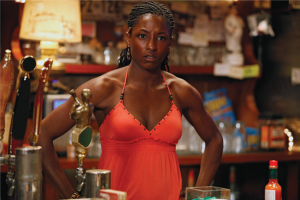

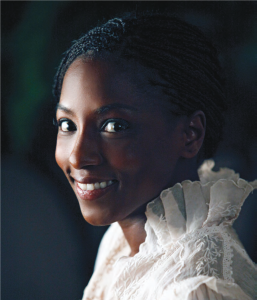
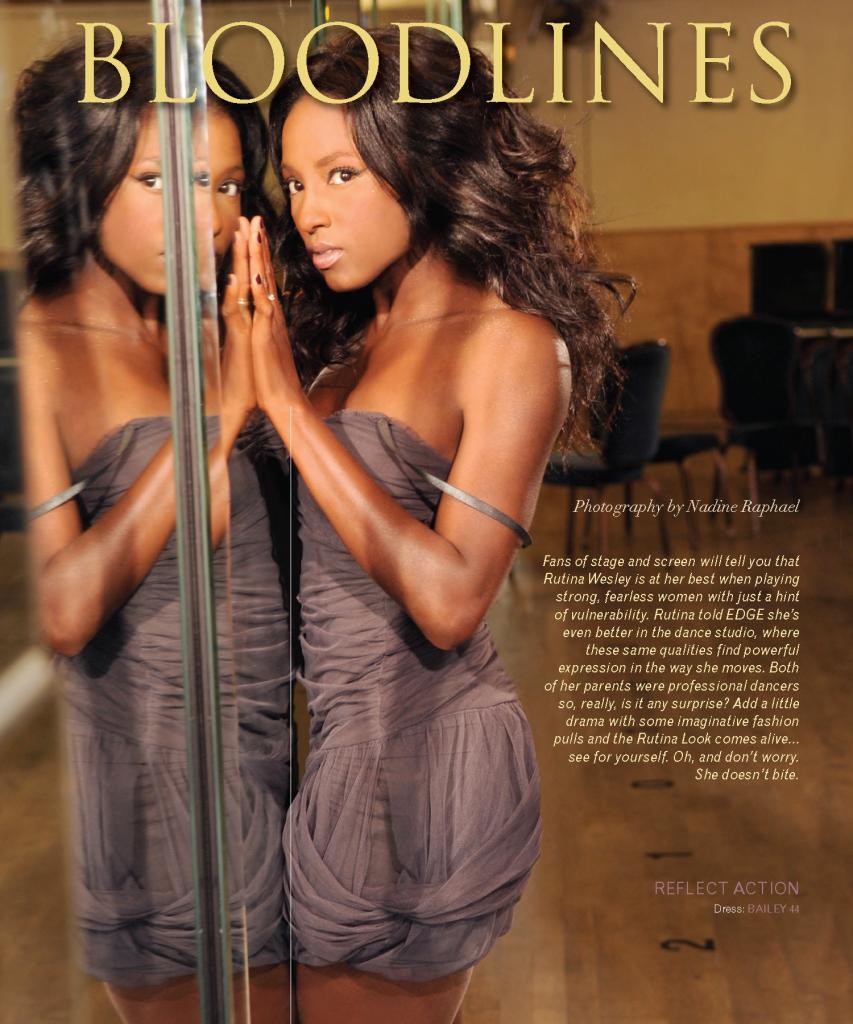
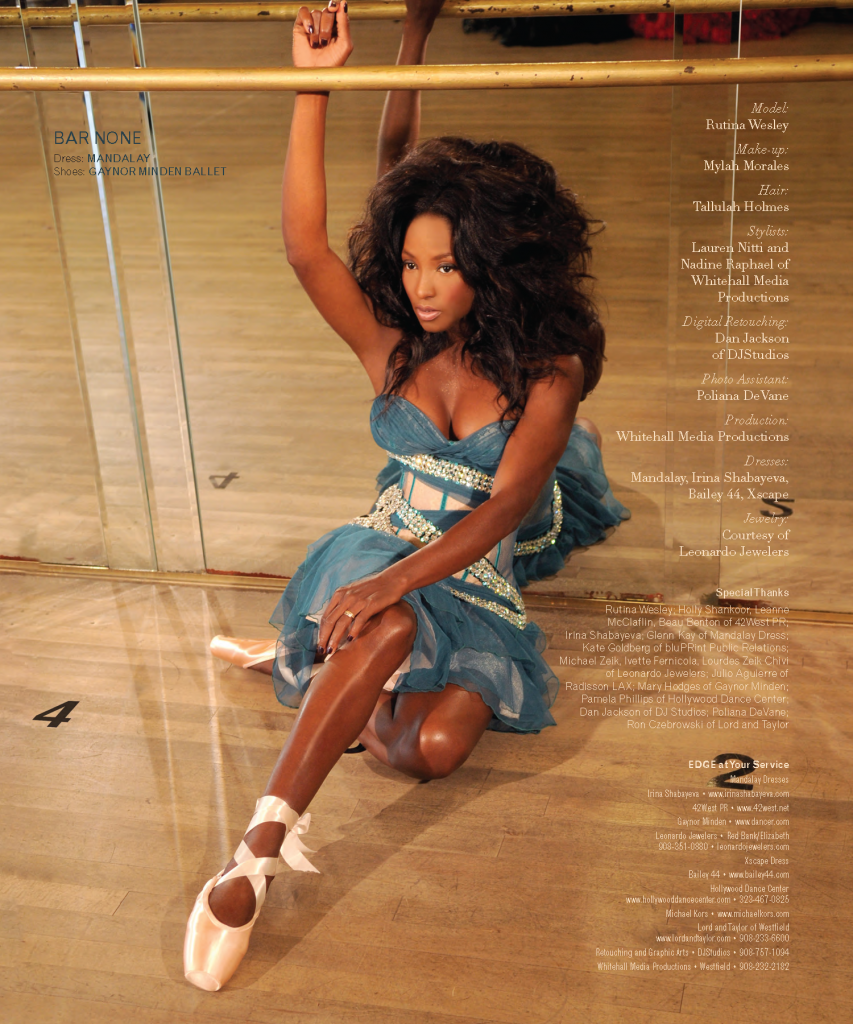
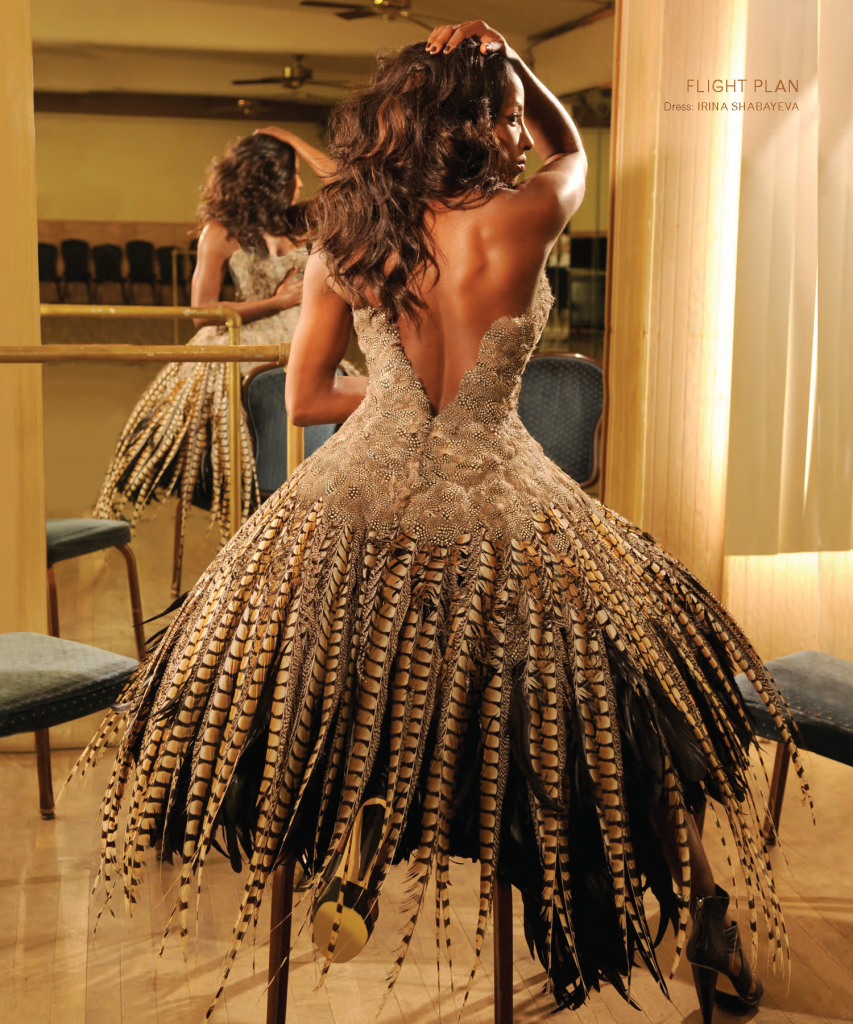

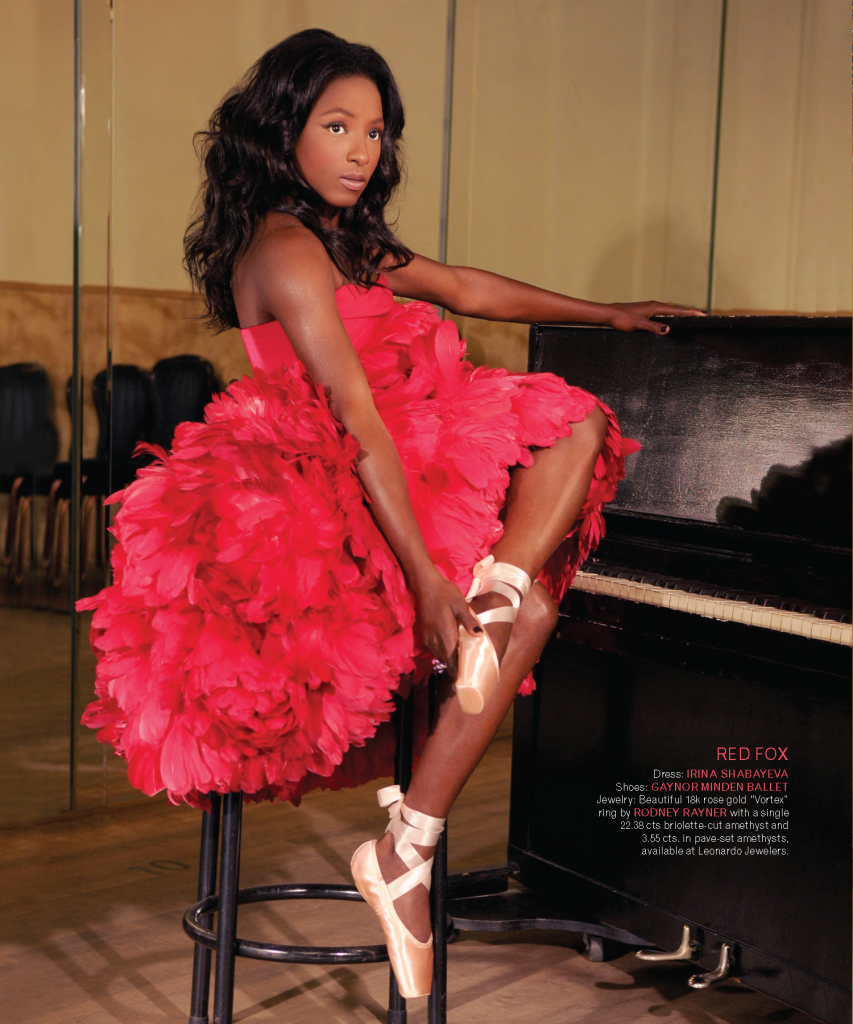
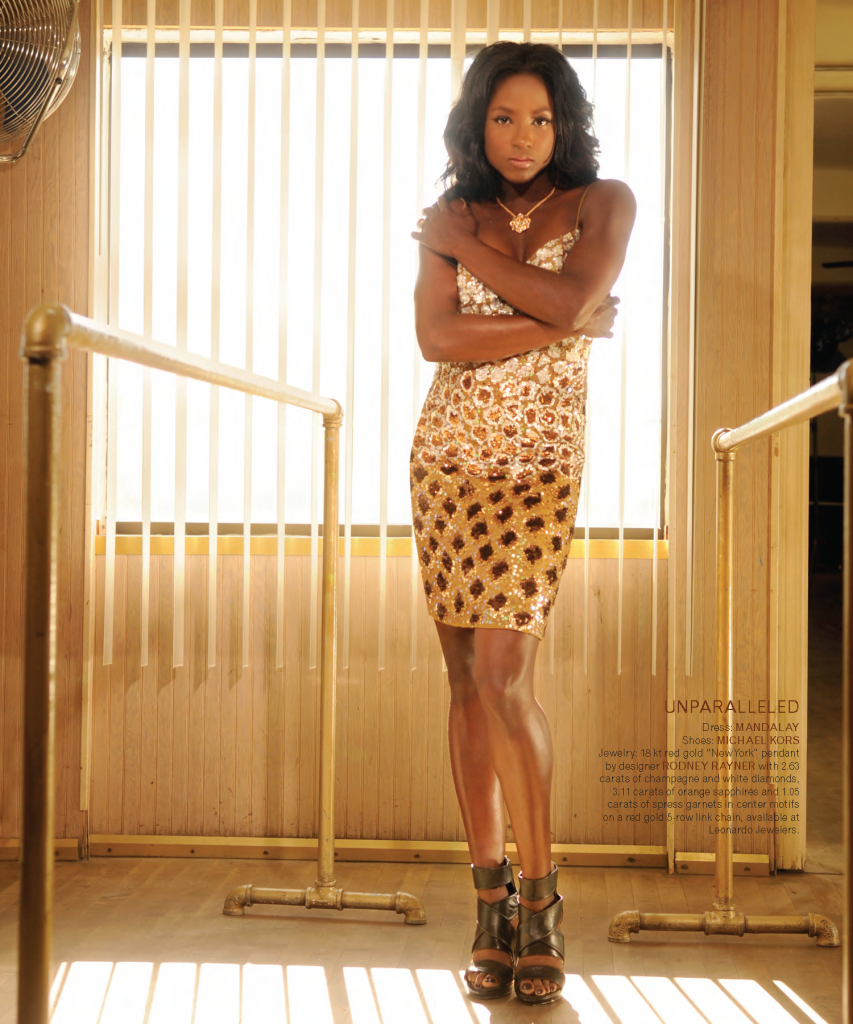

 Wow. Has it really come to this? I recently learned there is someone at this magazine who has been forbidden to purchase his own clothing. I won’t say who it is, but you’ll find his name closer to the top of the masthead than the bottom. He is a reasonable, intelligent man with a good eye for what works and what doesn’t—except when he’s standing in front of a mirror. The expensive, yellow plaid shirt that doesn’t go with anything (except possibly a wood chipper) was the straw that broke the camel’s back. Since then, his wife must be present to approve all apparel purchases. This is nonnegotiable. If you—as a husband, wife or significant other—feel that you are headed toward this totalitarian state of clothes shopping, I can help. As the longtime host of the TV series A Makeover Story, it was actually my job. I found that focusing on five “essentials” often was enough to move fashion disasters in a safe direction, so that’s how I’ll handle it here. And just to keep things in season, we’ll focus on autumn. Men, stick to this plan and you never hear another What were you thinking! Ladies, arm your man with this information and you’ll soon be cutting him some slack (instead of cutting up his slacks) when he comes home from the store. Buy two sport coats. Although price-wise they will represent the lion’s share of the new wardrobe investment, quality navy blue wool and brown corduroy sport coats are an absolute necessity that will create endless outfits. I know that men can be tempted, at times, to purchase grey, black, or herringbone blazers (all of which can be dazzling), but coupling those colors and patterns with shirts, slacks and ties dramatically widens the playing field for fashion faux pas. I highly recommend J. Crew’s Cashmere Ludlow Legacy Blazer ($575) and Banana Republic’s Tailored Corduroy 2- Button Blazer in Camel ($198).
Wow. Has it really come to this? I recently learned there is someone at this magazine who has been forbidden to purchase his own clothing. I won’t say who it is, but you’ll find his name closer to the top of the masthead than the bottom. He is a reasonable, intelligent man with a good eye for what works and what doesn’t—except when he’s standing in front of a mirror. The expensive, yellow plaid shirt that doesn’t go with anything (except possibly a wood chipper) was the straw that broke the camel’s back. Since then, his wife must be present to approve all apparel purchases. This is nonnegotiable. If you—as a husband, wife or significant other—feel that you are headed toward this totalitarian state of clothes shopping, I can help. As the longtime host of the TV series A Makeover Story, it was actually my job. I found that focusing on five “essentials” often was enough to move fashion disasters in a safe direction, so that’s how I’ll handle it here. And just to keep things in season, we’ll focus on autumn. Men, stick to this plan and you never hear another What were you thinking! Ladies, arm your man with this information and you’ll soon be cutting him some slack (instead of cutting up his slacks) when he comes home from the store. Buy two sport coats. Although price-wise they will represent the lion’s share of the new wardrobe investment, quality navy blue wool and brown corduroy sport coats are an absolute necessity that will create endless outfits. I know that men can be tempted, at times, to purchase grey, black, or herringbone blazers (all of which can be dazzling), but coupling those colors and patterns with shirts, slacks and ties dramatically widens the playing field for fashion faux pas. I highly recommend J. Crew’s Cashmere Ludlow Legacy Blazer ($575) and Banana Republic’s Tailored Corduroy 2- Button Blazer in Camel ($198).  As you’ll see, navy and camel act as an absolute and infallible base for each and every autumn ensemble. They make up the keystone in the flying buttress of a well-rounded wardrobe. Purchase two pairs of Chinos. Don’t call them Khakis, because they aren’t the same. What most people consider a stereotypical khaki is really just the bottom of the barrel in the world of men’s cotton trousers. I hate to say it, because they serve many a purpose, but it’s true. The word Khaki, by the way, comes from the Urdu word for dusty. During the Raj, English soldiers would dye their whites the color of the omnipresent and unavoidable dust in south and central India. Thus, was born both the color and the English word. Chinos, the more sophisticated cousin, are distinguished by the combed cotton sheen and the lack of back pocket cover flaps. Lacoste’s Classic Chino in Beige ($88) is perfectly conservative and appropriate for any occasion. Get two tailored shirts. You want the real deal here. A well-constructed gent’s wardrobe requires them in at least two colors; white and a light blue pattern. I’ve always been a fan of the Brooks Brothers Luxury Slim Fit shirt ($79.50). It is timeless, fits properly, and is available with or without a French cuff. Brooks Brothers includes its trademark “knot” cufflinks with each French cuff purchase, which is a fantastic pair of fashion training wheels if I’ve ever seen them. Every man needs an essential brown shoe. Keep in mind, a go-to black shoe is always a necessity, but I find that in fall, a brown shoe is always more appropriate and will mesh with infinitely more outfit components. Hugo Boss has always been a favorite of mine. And, in this case, the Saharian Chukka Boot in Dark Brown ($275) is a timeless, rich choice. Chukka sub-ankle boots are a great option for brisk months and seem to carry with them both endless style and rugged masculinity—two big advantages in my book. Most men have no idea what it’s like to suffer for the beauty of a shoe, and this will be no exception. Chukka’s wear like a Jimmy Choo, but feel like a Birkenstock. I know, it’s so unfair! Accessorize. No male wardrobe would ever be complete without a little accoutrement. I know most men shy away from (if not perpetually underestimate) the importance of the accessory. A stubborn man can mount successful arguments against a beautiful watch, a great pair of cufflinks or a dazzling ring. However, a first-rate leather belt is a must have, not a should-have. Again, since we’re building our fashion masterpiece within the framework of an autumnal palate, I highly suggest brown—if for no other reason than the fact that brown leathers seem to retain more beauty in texture, and stand out more prominently against other fabrics. Ralph Lauren’s Saddle Leather Belt in Papaya ($175) is a winner through and through. Its gold roller buckle and rich saddle leather echo country craftsmanship, while conjuring images of the luxury of Savile Row. A suddenly and unexpectedly well-dressed man can be a startling reminder of all the other fantastic, useful, and sometimes mystifying purposes he serves. So go forth and shop with new purpose and confidence. To the Short Hills… and beyond! EDGE
As you’ll see, navy and camel act as an absolute and infallible base for each and every autumn ensemble. They make up the keystone in the flying buttress of a well-rounded wardrobe. Purchase two pairs of Chinos. Don’t call them Khakis, because they aren’t the same. What most people consider a stereotypical khaki is really just the bottom of the barrel in the world of men’s cotton trousers. I hate to say it, because they serve many a purpose, but it’s true. The word Khaki, by the way, comes from the Urdu word for dusty. During the Raj, English soldiers would dye their whites the color of the omnipresent and unavoidable dust in south and central India. Thus, was born both the color and the English word. Chinos, the more sophisticated cousin, are distinguished by the combed cotton sheen and the lack of back pocket cover flaps. Lacoste’s Classic Chino in Beige ($88) is perfectly conservative and appropriate for any occasion. Get two tailored shirts. You want the real deal here. A well-constructed gent’s wardrobe requires them in at least two colors; white and a light blue pattern. I’ve always been a fan of the Brooks Brothers Luxury Slim Fit shirt ($79.50). It is timeless, fits properly, and is available with or without a French cuff. Brooks Brothers includes its trademark “knot” cufflinks with each French cuff purchase, which is a fantastic pair of fashion training wheels if I’ve ever seen them. Every man needs an essential brown shoe. Keep in mind, a go-to black shoe is always a necessity, but I find that in fall, a brown shoe is always more appropriate and will mesh with infinitely more outfit components. Hugo Boss has always been a favorite of mine. And, in this case, the Saharian Chukka Boot in Dark Brown ($275) is a timeless, rich choice. Chukka sub-ankle boots are a great option for brisk months and seem to carry with them both endless style and rugged masculinity—two big advantages in my book. Most men have no idea what it’s like to suffer for the beauty of a shoe, and this will be no exception. Chukka’s wear like a Jimmy Choo, but feel like a Birkenstock. I know, it’s so unfair! Accessorize. No male wardrobe would ever be complete without a little accoutrement. I know most men shy away from (if not perpetually underestimate) the importance of the accessory. A stubborn man can mount successful arguments against a beautiful watch, a great pair of cufflinks or a dazzling ring. However, a first-rate leather belt is a must have, not a should-have. Again, since we’re building our fashion masterpiece within the framework of an autumnal palate, I highly suggest brown—if for no other reason than the fact that brown leathers seem to retain more beauty in texture, and stand out more prominently against other fabrics. Ralph Lauren’s Saddle Leather Belt in Papaya ($175) is a winner through and through. Its gold roller buckle and rich saddle leather echo country craftsmanship, while conjuring images of the luxury of Savile Row. A suddenly and unexpectedly well-dressed man can be a startling reminder of all the other fantastic, useful, and sometimes mystifying purposes he serves. So go forth and shop with new purpose and confidence. To the Short Hills… and beyond! EDGE
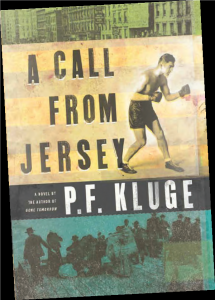 the very nature of estrangement and reconciliation. The Union County hamlet of Berkeley Heights serves as the epicenter for much of A Call from Jersey. Kluge is an unapologetic Jersey Boy with an intimate understanding of the suburban landscape. The story, much of it set in the 1980s, stretches across generations and cultures—and occasionally through the Holland Tunnel—to connect a father and son so preoccupied with how their lives have turned out that they can barely manage an adult conversation when they’re together. Gentle ironies define this relationship. Hans, a seventy-something German- American, is feeling lost in America. His son, George, is a travel writer capable of describing the exotic and mundane with equal aplomb, yet can’t quite put his finger on exactly where, or even what, “home” is. Kluge, it’s worth noting, is the man who supplied the literary inspiration for a pair of iconic films, Dog Day Afternoon and Eddie and the Cruisers. The former, about a Brooklyn bank robbery gone agonizingly awry, starred Al Pacino, fresh off Serpico and his two Godfather triumphs. The latter, about a fictional 1960s Jersey rock band, probably qualifies as a cult classic; certainly that’s true here in the Garden State. From a storytelling standpoint, the most appealing aspect of Eddie—the book and the film—is how effortlessly the narrative moves between past and present. Kluge utilizes time-shifting to great effect again in A Call from Jersey, transporting readers back to the 1930s in order to cobble together a kind of baseline for his characters. There we meet a young Hans, fresh off the boat from Germany, determined to shed his “greenhorn” label and start an American family. As the gap narrows between Hans and George, both timewise and relationship-wise, the author fills in the pertinent details to set up the surprise finish. The most distinctive aspect of A Call from Jersey is how comfortable Kluge is in his two different skins. The book is narrated in the first person, but alternates between Hans and George. The pressure of getting it right for two characters, says Kluge, is outweighed by the advantages of writing in multiple voices. “When you are writing, you are faced with that choice between first and third person,” he explains. “The first person is attractive to young writers because you can put a lot of yourself into the persona of the narrator. That’s fine, except there are certain places you can’t go. You can’t ‘play the field’—you’re a little bit stuck with that one person. The third person offers a larger palette, but you are at a distance from the characters.” “I like the idea of alternating first person narrators, though it’s not without problems. The voices have to be persuasive and can’t be too much alike. That challenged me, but I like it when it works. It combines the advantages of first and third person.” As Kluge’s two main characters stumble toward a long-neglected father-son reunion, they also pursue reunions of their own. George, feeling lost in his late 30s, is staring down the barrel of his 20th with that familiar mix of expectation and anxiety. Kluge, it is worth noting, is headed toward his 50th reunion this fall. In his case, it’s a not-insignificant trip from Gambier, Ohio, where he is Writer in Residence at Kenyon College. “The reason I faithfully attend my high school reunions is to see how lives are turning out,” he explains. “It’s what writers do. At a certain point, elements of competition, appearance and accomplishment dominate reunions. But over time it mellows out. You just want to stare at people and remember and connect. Reunions are about wanting to belong to that same bunch you had in the beginning. Or what’s left of it.”
the very nature of estrangement and reconciliation. The Union County hamlet of Berkeley Heights serves as the epicenter for much of A Call from Jersey. Kluge is an unapologetic Jersey Boy with an intimate understanding of the suburban landscape. The story, much of it set in the 1980s, stretches across generations and cultures—and occasionally through the Holland Tunnel—to connect a father and son so preoccupied with how their lives have turned out that they can barely manage an adult conversation when they’re together. Gentle ironies define this relationship. Hans, a seventy-something German- American, is feeling lost in America. His son, George, is a travel writer capable of describing the exotic and mundane with equal aplomb, yet can’t quite put his finger on exactly where, or even what, “home” is. Kluge, it’s worth noting, is the man who supplied the literary inspiration for a pair of iconic films, Dog Day Afternoon and Eddie and the Cruisers. The former, about a Brooklyn bank robbery gone agonizingly awry, starred Al Pacino, fresh off Serpico and his two Godfather triumphs. The latter, about a fictional 1960s Jersey rock band, probably qualifies as a cult classic; certainly that’s true here in the Garden State. From a storytelling standpoint, the most appealing aspect of Eddie—the book and the film—is how effortlessly the narrative moves between past and present. Kluge utilizes time-shifting to great effect again in A Call from Jersey, transporting readers back to the 1930s in order to cobble together a kind of baseline for his characters. There we meet a young Hans, fresh off the boat from Germany, determined to shed his “greenhorn” label and start an American family. As the gap narrows between Hans and George, both timewise and relationship-wise, the author fills in the pertinent details to set up the surprise finish. The most distinctive aspect of A Call from Jersey is how comfortable Kluge is in his two different skins. The book is narrated in the first person, but alternates between Hans and George. The pressure of getting it right for two characters, says Kluge, is outweighed by the advantages of writing in multiple voices. “When you are writing, you are faced with that choice between first and third person,” he explains. “The first person is attractive to young writers because you can put a lot of yourself into the persona of the narrator. That’s fine, except there are certain places you can’t go. You can’t ‘play the field’—you’re a little bit stuck with that one person. The third person offers a larger palette, but you are at a distance from the characters.” “I like the idea of alternating first person narrators, though it’s not without problems. The voices have to be persuasive and can’t be too much alike. That challenged me, but I like it when it works. It combines the advantages of first and third person.” As Kluge’s two main characters stumble toward a long-neglected father-son reunion, they also pursue reunions of their own. George, feeling lost in his late 30s, is staring down the barrel of his 20th with that familiar mix of expectation and anxiety. Kluge, it is worth noting, is headed toward his 50th reunion this fall. In his case, it’s a not-insignificant trip from Gambier, Ohio, where he is Writer in Residence at Kenyon College. “The reason I faithfully attend my high school reunions is to see how lives are turning out,” he explains. “It’s what writers do. At a certain point, elements of competition, appearance and accomplishment dominate reunions. But over time it mellows out. You just want to stare at people and remember and connect. Reunions are about wanting to belong to that same bunch you had in the beginning. Or what’s left of it.”
 “}e21`perch in the L-shaped first-floor dining room, a table for 10 catty-corner from ours is being readied for guests. Before long, on our other side, a few tables are being pushed together by the busy floor crew. I ask a server how many will be in that party. He shrugs and says, “Either 10 or 12. We’ll find out when they get here.” Party Central in Kenilworth. Boulevard Five72 is fit for celebrations and, on this weekend night, folks everywhere are toasting one another. Servers sashay around the dining spaces briskly and purposefully as the evening promises to crescendo every 15 minutes. Everyone and everything is dressed for the occasion. Approach the restaurant, which sits stately on the main thoroughfare that lends its name to Boulevard Five72, and you might think it looks something like a French chateau. Inside, there’s a bit of a French provincial feel to the décor, dominated by shades of beige and wood tones. It’s an appropriately restful backdrop to the constant-motion dining scene. Snag a bottle of wine from the list and settle in. Chef-partner Scott Snyder’s menu is amenable to almost anything you might be in the mood for. I’d suggest going for one of the value-priced red wines from Spain and letting it do-si-do with the fava bean ravioli nestled in a rustic rabbit ragout. It’s the standout dish on the menu of the moment at Boulevard Five72—a partnership of stalwarts from the south of France that have long earned their stripes at the table. Snyder finishes the starter with an ethereal pouf of truffle scented mascarpone that provides yet another flavor bridge from rabbit to fava to pasta. Or you might consider the crab cake, which here comes accompanied by a coarse chop of a salsa, starring chickpeas
“}e21`perch in the L-shaped first-floor dining room, a table for 10 catty-corner from ours is being readied for guests. Before long, on our other side, a few tables are being pushed together by the busy floor crew. I ask a server how many will be in that party. He shrugs and says, “Either 10 or 12. We’ll find out when they get here.” Party Central in Kenilworth. Boulevard Five72 is fit for celebrations and, on this weekend night, folks everywhere are toasting one another. Servers sashay around the dining spaces briskly and purposefully as the evening promises to crescendo every 15 minutes. Everyone and everything is dressed for the occasion. Approach the restaurant, which sits stately on the main thoroughfare that lends its name to Boulevard Five72, and you might think it looks something like a French chateau. Inside, there’s a bit of a French provincial feel to the décor, dominated by shades of beige and wood tones. It’s an appropriately restful backdrop to the constant-motion dining scene. Snag a bottle of wine from the list and settle in. Chef-partner Scott Snyder’s menu is amenable to almost anything you might be in the mood for. I’d suggest going for one of the value-priced red wines from Spain and letting it do-si-do with the fava bean ravioli nestled in a rustic rabbit ragout. It’s the standout dish on the menu of the moment at Boulevard Five72—a partnership of stalwarts from the south of France that have long earned their stripes at the table. Snyder finishes the starter with an ethereal pouf of truffle scented mascarpone that provides yet another flavor bridge from rabbit to fava to pasta. Or you might consider the crab cake, which here comes accompanied by a coarse chop of a salsa, starring chickpeas 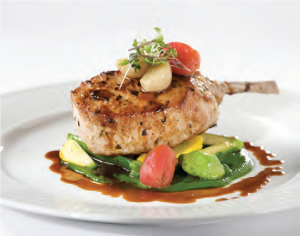 with a cameo of fruit. The punchline of the appetizer? A flash of sriracha sauce, moderated by avocado. As I ate, I thought there’d be nothing wrong with giving that hot-fun sriracha more of a chance to dance around the plate: Between the sweetness of the crab and the earthiness of the chickpeas, the dish has the foundation to stand up to more heat. Go for it. Shrimp punctuate a chunky corn chowder that benefits from a trio of compelling accents: smoky bacon, celery root and a touch of turnip. It’s a solid soup—one worth exploring all summer long—as Snyder and his kitchen crew riff on the shellfish and switch around the accenting vegetables to stay in season. One vegetable I wish they’d switch out is the red flannel hash that’s made from
with a cameo of fruit. The punchline of the appetizer? A flash of sriracha sauce, moderated by avocado. As I ate, I thought there’d be nothing wrong with giving that hot-fun sriracha more of a chance to dance around the plate: Between the sweetness of the crab and the earthiness of the chickpeas, the dish has the foundation to stand up to more heat. Go for it. Shrimp punctuate a chunky corn chowder that benefits from a trio of compelling accents: smoky bacon, celery root and a touch of turnip. It’s a solid soup—one worth exploring all summer long—as Snyder and his kitchen crew riff on the shellfish and switch around the accenting vegetables to stay in season. One vegetable I wish they’d switch out is the red flannel hash that’s made from 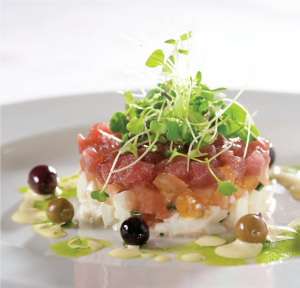 beets and plated with the grilled salmon. The grainy mustard and pesto-like spinach purée adds spot-on counterpoints to the moist fish, but the root vegetable clashes with the salmon. A basic strip loin, meanwhile, showed the kitchen’s precision, and the rich reduction of red wine swirled on the plate was all the steak needed. But a haystack of onions that looked more frizzled than frittered, as the menu described, proved an amiable companion, so we gobbled it all up. Why not? Steak and onions are a heavenly marriage. As are shellfish and arborio, the basis for Boulevard Five72’s risotto. It’s heavy on the truffle in its lobster broth, which I know draws applause from a multitude of
beets and plated with the grilled salmon. The grainy mustard and pesto-like spinach purée adds spot-on counterpoints to the moist fish, but the root vegetable clashes with the salmon. A basic strip loin, meanwhile, showed the kitchen’s precision, and the rich reduction of red wine swirled on the plate was all the steak needed. But a haystack of onions that looked more frizzled than frittered, as the menu described, proved an amiable companion, so we gobbled it all up. Why not? Steak and onions are a heavenly marriage. As are shellfish and arborio, the basis for Boulevard Five72’s risotto. It’s heavy on the truffle in its lobster broth, which I know draws applause from a multitude of  diners impressed by the presence of extreme luxury. I’m a little less drawn to the use of truffle oil than most; I think it overwhelms shellfish, in particular, keeping its unique character in the closet. We added character to our entrées in the form of two sides well worth the supplement. Spanish chips are one of the planet’s most enjoyable foods. Here the thick-cut potato slices are crisp and crunchy and judiciously dusted with pimenton and salt. Good greens are spiced just right—and right for just about any of Boulevard Five72’s entrées. My suggestion re the greens? Serve with a wedge of lemon to give diners the option of adding a little zing as desired. There’s citrus aplenty in the steamed pudding cake, an elegant finale served with a side of blackberry sorbet. An updated strawberry shortcake was underscored by a faint drop of balsamic vinegar and partnered with a creamy, subtle basil gelato. A favorite at my table was the dark chocolate-caramel tart, with its delightful sprinkling of fleur de sel and a cloud of mascarpone mousse offered as a finishing flourish. As we wound down our dinner, servers were gearing up for yet another large-party table. Amid all the activity, you might notice a slight slow-down between appetizers and main courses, and maybe your entrée plates are left to sit a tad too long after you’ve set down knife and fork. But the crew, largely, performs admirably. The crescendos continue at Boulevard Five72. EDGE
diners impressed by the presence of extreme luxury. I’m a little less drawn to the use of truffle oil than most; I think it overwhelms shellfish, in particular, keeping its unique character in the closet. We added character to our entrées in the form of two sides well worth the supplement. Spanish chips are one of the planet’s most enjoyable foods. Here the thick-cut potato slices are crisp and crunchy and judiciously dusted with pimenton and salt. Good greens are spiced just right—and right for just about any of Boulevard Five72’s entrées. My suggestion re the greens? Serve with a wedge of lemon to give diners the option of adding a little zing as desired. There’s citrus aplenty in the steamed pudding cake, an elegant finale served with a side of blackberry sorbet. An updated strawberry shortcake was underscored by a faint drop of balsamic vinegar and partnered with a creamy, subtle basil gelato. A favorite at my table was the dark chocolate-caramel tart, with its delightful sprinkling of fleur de sel and a cloud of mascarpone mousse offered as a finishing flourish. As we wound down our dinner, servers were gearing up for yet another large-party table. Amid all the activity, you might notice a slight slow-down between appetizers and main courses, and maybe your entrée plates are left to sit a tad too long after you’ve set down knife and fork. But the crew, largely, performs admirably. The crescendos continue at Boulevard Five72. EDGE
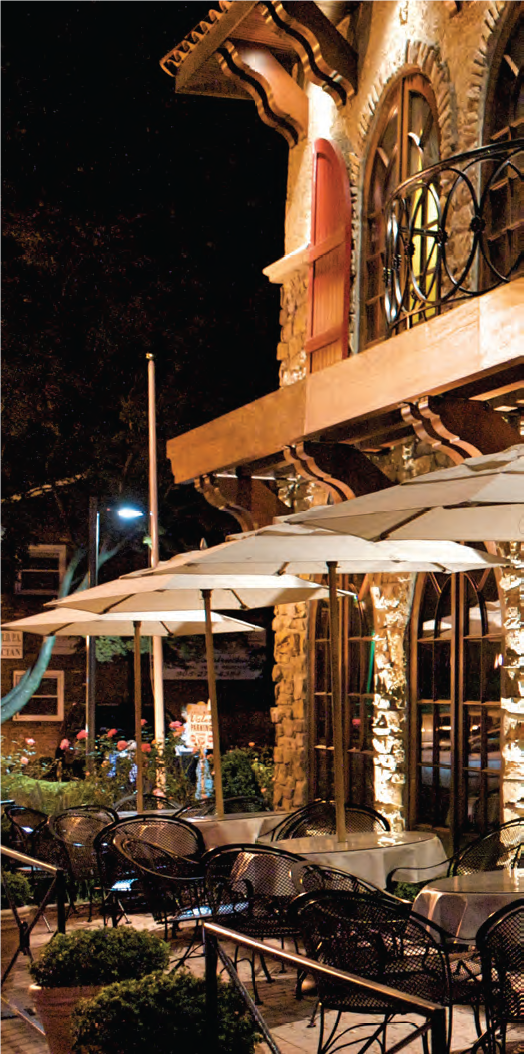


 Is it too much to ask that people not buy their first saltwater aquarium along with the fishes, live rock, and invertebrates all on their first visit to a pet shop? I experiment constantly, and found the very best aquarium I ever kept was limited to live rocks for a whole year before I put any fish in. I always tell my friends to “grow something” in the water first. No matter how many products are available to help start aquariums quickly, the aquarist’s best friend starting out is time. • Patronize the local brick & mortar pet shop and—I’ll say it again—beware of bargains. Even though it may not be able to compete with Internet prices, your local pet shop was likely opened as a labor of love and expertise; these folks are looking to make a living, not a fortune. Pet shop insiders will be the most generous of people with their time, experience, and good advice. However, be aware of the fishmonger who repeats whatever it is you just said, who agrees with a wayward premise. (Yeah! I always feed live guppies to all my cichlids.) If the advice smells like a bucket of week-old dead fish, this is what you’ll probably have next week if you buy from this guy. I only thank my lucky stars that Clownfish are now being commercially farmed at facilities like the ORA hatchery complex in Ft. Pierce, Florida and need not be collected from the wild. Had Nemo been an equally adorable Banggai Cardinalfish, collection pressures on the small wild populations would definitely have put this species at serious risk, even though it too is able to be bred in captivity; just not enough to supply the demand for fish that a movie like Nemo would generate. Although some of us in the industry wrestle with our consciences, in the end we believe that every person who begins a saltwater aquarium—regardless of the outcome— gains new respect and appreciation for our delicate planet. I can’t think of any other exercise that shows us in such acute detail just how difficult it can be to keep a small being living under our care. Perhaps if more people dedicated themselves to maintaining flourishing saltwater tanks, the Gulf of Mexico would still support a shrimping industry, global warming would be addressed in a more proactive way, and we would realize that the line between the coral reefs of Fiji and the Arthur Kill can be an astoundingly fine one. EDGE
Is it too much to ask that people not buy their first saltwater aquarium along with the fishes, live rock, and invertebrates all on their first visit to a pet shop? I experiment constantly, and found the very best aquarium I ever kept was limited to live rocks for a whole year before I put any fish in. I always tell my friends to “grow something” in the water first. No matter how many products are available to help start aquariums quickly, the aquarist’s best friend starting out is time. • Patronize the local brick & mortar pet shop and—I’ll say it again—beware of bargains. Even though it may not be able to compete with Internet prices, your local pet shop was likely opened as a labor of love and expertise; these folks are looking to make a living, not a fortune. Pet shop insiders will be the most generous of people with their time, experience, and good advice. However, be aware of the fishmonger who repeats whatever it is you just said, who agrees with a wayward premise. (Yeah! I always feed live guppies to all my cichlids.) If the advice smells like a bucket of week-old dead fish, this is what you’ll probably have next week if you buy from this guy. I only thank my lucky stars that Clownfish are now being commercially farmed at facilities like the ORA hatchery complex in Ft. Pierce, Florida and need not be collected from the wild. Had Nemo been an equally adorable Banggai Cardinalfish, collection pressures on the small wild populations would definitely have put this species at serious risk, even though it too is able to be bred in captivity; just not enough to supply the demand for fish that a movie like Nemo would generate. Although some of us in the industry wrestle with our consciences, in the end we believe that every person who begins a saltwater aquarium—regardless of the outcome— gains new respect and appreciation for our delicate planet. I can’t think of any other exercise that shows us in such acute detail just how difficult it can be to keep a small being living under our care. Perhaps if more people dedicated themselves to maintaining flourishing saltwater tanks, the Gulf of Mexico would still support a shrimping industry, global warming would be addressed in a more proactive way, and we would realize that the line between the coral reefs of Fiji and the Arthur Kill can be an astoundingly fine one. EDGE 
 The casualty list in this epic, microscopic battle being waged within your body includes a runny nose, scratchy throat, watery eyes, itchy hives and, in the most serious cases, a potentially lifethreatening asthma attack. “Pet dander can activate cells in the immune system,” confirms Samuel D. Kahnowitz, MD, FCCP, FACP, Chief of Pulmonary Medicine and Medical Director of Respiratory Therapy at Trinitas Regional Medical Center. “The body then makes inflammatory substances that constrict the muscles around the airway, and cause swelling on the inside of the airways, making it harder to breathe.” Reactions to pet allergies account for an increasing number of doctor and emergency room visits in this country, so the medical community is taking this trend seriously. To a layman, at least, the obvious question is, “Has pet dander somehow gotten ‘worse’ or are people becoming more sensitive to it?” Actually the same question could be asked about our food and environment—allergies in general seem to be more prevalent, and more serious, than ever. It turns out that we may be the problem. Indeed studies suggest that our country’s obsession with cleanliness may be to blame for creating hypersensitive immune systems, which now react to harmless things around us. “Our environment has improved, so we don’t have to worry about fighting off dangerous parasites,” explains Richard J. Bukosky, MD, an allergist in Linden. “The allergic antibody doesn’t have a whole lot to do. It starts to ‘pick’ on things that we’re exposed to in the environment that are completely harmless.” While there is still no permanent cure for pet allergies, there are plenty of options available for minimizing their effects on your life—and many of them don’t require finding a new home for Fluffy or Fido: Minimize exposure to pets. The less exposure to the offending pet, the better. Opting to find a new home for your pet may help in the long run, though it can take up to 20 weeks after the pet leaves before the allergen levels really dissipate.
The casualty list in this epic, microscopic battle being waged within your body includes a runny nose, scratchy throat, watery eyes, itchy hives and, in the most serious cases, a potentially lifethreatening asthma attack. “Pet dander can activate cells in the immune system,” confirms Samuel D. Kahnowitz, MD, FCCP, FACP, Chief of Pulmonary Medicine and Medical Director of Respiratory Therapy at Trinitas Regional Medical Center. “The body then makes inflammatory substances that constrict the muscles around the airway, and cause swelling on the inside of the airways, making it harder to breathe.” Reactions to pet allergies account for an increasing number of doctor and emergency room visits in this country, so the medical community is taking this trend seriously. To a layman, at least, the obvious question is, “Has pet dander somehow gotten ‘worse’ or are people becoming more sensitive to it?” Actually the same question could be asked about our food and environment—allergies in general seem to be more prevalent, and more serious, than ever. It turns out that we may be the problem. Indeed studies suggest that our country’s obsession with cleanliness may be to blame for creating hypersensitive immune systems, which now react to harmless things around us. “Our environment has improved, so we don’t have to worry about fighting off dangerous parasites,” explains Richard J. Bukosky, MD, an allergist in Linden. “The allergic antibody doesn’t have a whole lot to do. It starts to ‘pick’ on things that we’re exposed to in the environment that are completely harmless.” While there is still no permanent cure for pet allergies, there are plenty of options available for minimizing their effects on your life—and many of them don’t require finding a new home for Fluffy or Fido: Minimize exposure to pets. The less exposure to the offending pet, the better. Opting to find a new home for your pet may help in the long run, though it can take up to 20 weeks after the pet leaves before the allergen levels really dissipate.  If your dog or cat is here to stay, make sure to keep it out of your bedroom—the place where you spend most of your time—and wash your hands thoroughly after you’ve touched your pet. Weekly bathing or grooming (done by someone other than the person with the allergies) may also help keep allergens at bay. Keep it clean. Daily vacuuming and washing-down of surfaces can help clear some of the allergens—especially if you use a vacuum with a HEPA filter that can trap the tiny particles. Removing carpeting, drapery, stuffed toys and other soft fabrics can help reduce the number of places where pet dander can become trapped. “I really push for them to allergy-proof the bedroom—get rid of the carpeting and the animals, get a dehumidifier and a HEPA filter, avoid down comforters and get allergy-proofing casing for the pillows and mattresses,” Dr. Bukosky says. Consider that it might not be your pet. Even if allergy testing turns up an allergic reaction, it may not actually be your animal that’s causing the wheezing. “Dogs roam around, and it might not be the dog himself—it may be an irritant he’s picking up outside, like wood chips or rag weed,” says Dr. Kahnowitz. Take antihistamines. Newer over-the-counter formulations, like Zyrtec and Claritin, are more potent and less likely to cause drowsiness and other unpleasant side effects. Try a more serious approach. Doctors have become more aggressive in treating allergies, often including steroids in the treatment plan. “We’re pushing steroids more,” Dr. Bukosky says. “We used to use a montelukast (Singulair) a lot, but we’ve started to use inhaled steroids more—for nasal allergies, internasal steroids are a good option.” Of course, pet allergies can also be treated with a program of allergy immunizations. “We push for immunizations, which make it less likely that you’ll develop asthma,” says Dr. Bukosky. The regimens generally start with weekly shots, then as the treatment progresses, patients can go longer and longer between injections. Finally, there’s the do-nothing approach. These are the people who claim they have built an immunity to their animal. Is this really possible? The answer is yes…and no. Dr. Bukosky warns that what these pet owners believe to be happening may not actually be the case. “With daily exposure to the pet, a person with allergies may be having mild allergy-like attacks each day that use up the IgE antibody—just not enough to cause symptoms,” he says. “Then the child goes off to college, or is away from the pet for a long vacation, and has an asthma attack. So you may become ‘used to’ your pet, but you have to be in constant contact with it to avoid a serious reaction.”
If your dog or cat is here to stay, make sure to keep it out of your bedroom—the place where you spend most of your time—and wash your hands thoroughly after you’ve touched your pet. Weekly bathing or grooming (done by someone other than the person with the allergies) may also help keep allergens at bay. Keep it clean. Daily vacuuming and washing-down of surfaces can help clear some of the allergens—especially if you use a vacuum with a HEPA filter that can trap the tiny particles. Removing carpeting, drapery, stuffed toys and other soft fabrics can help reduce the number of places where pet dander can become trapped. “I really push for them to allergy-proof the bedroom—get rid of the carpeting and the animals, get a dehumidifier and a HEPA filter, avoid down comforters and get allergy-proofing casing for the pillows and mattresses,” Dr. Bukosky says. Consider that it might not be your pet. Even if allergy testing turns up an allergic reaction, it may not actually be your animal that’s causing the wheezing. “Dogs roam around, and it might not be the dog himself—it may be an irritant he’s picking up outside, like wood chips or rag weed,” says Dr. Kahnowitz. Take antihistamines. Newer over-the-counter formulations, like Zyrtec and Claritin, are more potent and less likely to cause drowsiness and other unpleasant side effects. Try a more serious approach. Doctors have become more aggressive in treating allergies, often including steroids in the treatment plan. “We’re pushing steroids more,” Dr. Bukosky says. “We used to use a montelukast (Singulair) a lot, but we’ve started to use inhaled steroids more—for nasal allergies, internasal steroids are a good option.” Of course, pet allergies can also be treated with a program of allergy immunizations. “We push for immunizations, which make it less likely that you’ll develop asthma,” says Dr. Bukosky. The regimens generally start with weekly shots, then as the treatment progresses, patients can go longer and longer between injections. Finally, there’s the do-nothing approach. These are the people who claim they have built an immunity to their animal. Is this really possible? The answer is yes…and no. Dr. Bukosky warns that what these pet owners believe to be happening may not actually be the case. “With daily exposure to the pet, a person with allergies may be having mild allergy-like attacks each day that use up the IgE antibody—just not enough to cause symptoms,” he says. “Then the child goes off to college, or is away from the pet for a long vacation, and has an asthma attack. So you may become ‘used to’ your pet, but you have to be in constant contact with it to avoid a serious reaction.”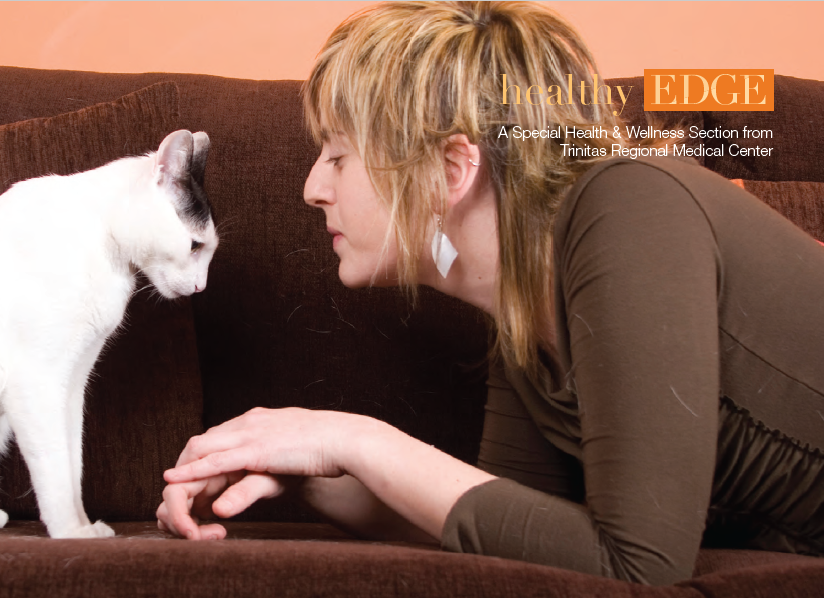
 Heart attack victims who have pets tend to live longer. Watching fish in a tank can lower blood pressure. In senior adults, canine companionship can keep mental health complications from turning into physical deterioration. Indeed, considerable evidence supports the healing potential of pet therapy. There is plenty of history to back up the power of pet therapy, too. The first documented account of animal therapy dates back to the 9th century in Gheel, Belgium, where farm animals were used to help disabled people cope. In Washington, D.C. in 1919, psychiatric patients at St. Elizabeth’s Hospital had dogs available for their recognized therapeutic value. And in the decades since, the medical community has come to embrace this interactive approach to improving the quality of life, both for patients in recovery and for those whose health may be in decline. For the record, today the more politically correct term for pet-related therapy is either Animal-Assisted Activities (AAA) or Animal-Assisted Therapy (AAT). AAA is a more casual meet-and-greet approach to hands-on contact between patients and pets, while AAT is a more formal clinical approach with patients who may be challenged physically, emotionally, or mentally.
Heart attack victims who have pets tend to live longer. Watching fish in a tank can lower blood pressure. In senior adults, canine companionship can keep mental health complications from turning into physical deterioration. Indeed, considerable evidence supports the healing potential of pet therapy. There is plenty of history to back up the power of pet therapy, too. The first documented account of animal therapy dates back to the 9th century in Gheel, Belgium, where farm animals were used to help disabled people cope. In Washington, D.C. in 1919, psychiatric patients at St. Elizabeth’s Hospital had dogs available for their recognized therapeutic value. And in the decades since, the medical community has come to embrace this interactive approach to improving the quality of life, both for patients in recovery and for those whose health may be in decline. For the record, today the more politically correct term for pet-related therapy is either Animal-Assisted Activities (AAA) or Animal-Assisted Therapy (AAT). AAA is a more casual meet-and-greet approach to hands-on contact between patients and pets, while AAT is a more formal clinical approach with patients who may be challenged physically, emotionally, or mentally. her five-year old beagle, Murphy. Both have been certified by St. Hubert’s. Reynolds recognized early on that Murphy had the necessary qualifications, since he had become an ambassador of goodwill in her own neighborhood, particularly among senior residents. Currently, the psych department’s group sessions are held at Trinitas, with special visits paid to the on-site nursing facility—the domain of Harley, another gifted pet “therapist.” The adult outpatient groups are often organized according to particular challenge. Two of the currently active groups are focusing on anxiety relief and partial vs. unconditional love. Reynolds refers to these sessions as her “puppy love” groups. “I really just knew I had to share him,” Reynolds says of Murphy, who wears a hospital staff photo ID badge, as do all the therapy dogs. It is attached to his favorite bandana; Reynolds realized that Murphy needed a work wardrobe and provided it. Murphy is typically on the job two or three days a month. A typical day includes sessions with two to three groups, each with five to ten patients. Patients are not the only recipients of Murphy’s healing powers. Staff members having a bad day often drop by for a visit and a pet. Murphy is happy to oblige. “No stranger is too strange for Murphy,” Reynolds says.
her five-year old beagle, Murphy. Both have been certified by St. Hubert’s. Reynolds recognized early on that Murphy had the necessary qualifications, since he had become an ambassador of goodwill in her own neighborhood, particularly among senior residents. Currently, the psych department’s group sessions are held at Trinitas, with special visits paid to the on-site nursing facility—the domain of Harley, another gifted pet “therapist.” The adult outpatient groups are often organized according to particular challenge. Two of the currently active groups are focusing on anxiety relief and partial vs. unconditional love. Reynolds refers to these sessions as her “puppy love” groups. “I really just knew I had to share him,” Reynolds says of Murphy, who wears a hospital staff photo ID badge, as do all the therapy dogs. It is attached to his favorite bandana; Reynolds realized that Murphy needed a work wardrobe and provided it. Murphy is typically on the job two or three days a month. A typical day includes sessions with two to three groups, each with five to ten patients. Patients are not the only recipients of Murphy’s healing powers. Staff members having a bad day often drop by for a visit and a pet. Murphy is happy to oblige. “No stranger is too strange for Murphy,” Reynolds says.
 Compounding this dilemma is the fact that dogs rarely display the pain they are experiencing at home on a trip to the animal hospital. Their adrenaline is pumping, their senses are under assault, and many experience off-the-charts anxiety—all of which can mask their pain once they hit the examining table. So what’s a vet to do? Keep score. They now can do so thanks to an elegantly simple document called the Canine Brief Pain Inventory (aka CBPI), which was developed at the University Pennsylvania School of Veterinary Medicine. The two-page evaluation sheet contains 11 carefully constructed questions, each of which can be answered on a sliding scale from 1 to 10—not by the doctor or (obviously) the patient, but by the dog owner. The result is a score which, over years of trials, has proven to be remarkably accurate. Why the dog owner? The answer would seem to be a no-brainer. After all, who better to report on a pet’s condition than the person who sees that pet more than anyone? But there’s the rub. The idea of taking what is purely observational data and then translating that into unimpeachable science is not always an easy sell. It’s not weaving straw into gold, mind you, but to some it has a little of that flavor. Not so says the CBPI’s creator, Dr. Dorothy Cimino Brown, Professor and Chief of Surgery at Penn who also has a practice within the university. “There is a whole scientific method surrounding how you build a numbers-based assessment tool from something that is inherently subjective,” she says. “It is a multi-step process during which you develop interview questions and then determine what and how they should be asked, and also how the answers should be recorded. We knew that the signs and behaviors associated with chronic pain in dogs can be non-dramatic, and therefore would be best known by dog owners. That is why we devoted five years and $500,000 on studies and focus groups in order to develop a scientifically reliable instrument.” According to Dr. Brown, there was a lot of tweaking during CBPI’s first two years, and mostly fine-tuning over the last three. Some of the questions to be included seemed obvious to everyone, such as How is your dog hopping into the car or getting upstairs? One development that surprised the researchers was a sleep question. Dogs experiencing pain related to cancer have trouble sleeping, so everyone assumed a sleep question would make the final cut. “It didn’t,” says Dr. Brown. “In building a question about sleep we could never get it to
Compounding this dilemma is the fact that dogs rarely display the pain they are experiencing at home on a trip to the animal hospital. Their adrenaline is pumping, their senses are under assault, and many experience off-the-charts anxiety—all of which can mask their pain once they hit the examining table. So what’s a vet to do? Keep score. They now can do so thanks to an elegantly simple document called the Canine Brief Pain Inventory (aka CBPI), which was developed at the University Pennsylvania School of Veterinary Medicine. The two-page evaluation sheet contains 11 carefully constructed questions, each of which can be answered on a sliding scale from 1 to 10—not by the doctor or (obviously) the patient, but by the dog owner. The result is a score which, over years of trials, has proven to be remarkably accurate. Why the dog owner? The answer would seem to be a no-brainer. After all, who better to report on a pet’s condition than the person who sees that pet more than anyone? But there’s the rub. The idea of taking what is purely observational data and then translating that into unimpeachable science is not always an easy sell. It’s not weaving straw into gold, mind you, but to some it has a little of that flavor. Not so says the CBPI’s creator, Dr. Dorothy Cimino Brown, Professor and Chief of Surgery at Penn who also has a practice within the university. “There is a whole scientific method surrounding how you build a numbers-based assessment tool from something that is inherently subjective,” she says. “It is a multi-step process during which you develop interview questions and then determine what and how they should be asked, and also how the answers should be recorded. We knew that the signs and behaviors associated with chronic pain in dogs can be non-dramatic, and therefore would be best known by dog owners. That is why we devoted five years and $500,000 on studies and focus groups in order to develop a scientifically reliable instrument.” According to Dr. Brown, there was a lot of tweaking during CBPI’s first two years, and mostly fine-tuning over the last three. Some of the questions to be included seemed obvious to everyone, such as How is your dog hopping into the car or getting upstairs? One development that surprised the researchers was a sleep question. Dogs experiencing pain related to cancer have trouble sleeping, so everyone assumed a sleep question would make the final cut. “It didn’t,” says Dr. Brown. “In building a question about sleep we could never get it to  mathematically behave. So we eliminated it. The problem was that not all owners sleep in the same room as their dog, so we dropped it from the inventory.” Brown’s team is pleased with the acceptance of the CBPI within the veterinary community. The form is available on the Internet at no charge, and it already has been downloaded more than 500 times; there is no way to track how often it is emailed or disseminated in other ways. After some initial resistance, the CBPI received glowing reviews in veterinary publications and today companies seeking FDA approval for canine pain medicine are using the CBPI to determine whether a drug is doing what it is supposed to do. Will the CBPI achieve “industry standard” status? From a research standpoint, it’s already a superb one. Considering that many local practitioners don’t use anything—they will ask how a dog is doing, but they don’t quantify it longitudinally—often a change in medication or treatment is based solely on feel. Old dogs can learn new tricks, as can vets who might initially resist an instrument such as the CBPI. From a patient record-keeping standpoint alone, says Dr. Brown, it just makes sense. “We recognize that the idea you can build an objective tool for a subjective situation is something new for veterinarians,” she offers. “But you can’t just pull six questions out of the air and expect to get a real evaluation.” EDGE
mathematically behave. So we eliminated it. The problem was that not all owners sleep in the same room as their dog, so we dropped it from the inventory.” Brown’s team is pleased with the acceptance of the CBPI within the veterinary community. The form is available on the Internet at no charge, and it already has been downloaded more than 500 times; there is no way to track how often it is emailed or disseminated in other ways. After some initial resistance, the CBPI received glowing reviews in veterinary publications and today companies seeking FDA approval for canine pain medicine are using the CBPI to determine whether a drug is doing what it is supposed to do. Will the CBPI achieve “industry standard” status? From a research standpoint, it’s already a superb one. Considering that many local practitioners don’t use anything—they will ask how a dog is doing, but they don’t quantify it longitudinally—often a change in medication or treatment is based solely on feel. Old dogs can learn new tricks, as can vets who might initially resist an instrument such as the CBPI. From a patient record-keeping standpoint alone, says Dr. Brown, it just makes sense. “We recognize that the idea you can build an objective tool for a subjective situation is something new for veterinarians,” she offers. “But you can’t just pull six questions out of the air and expect to get a real evaluation.” EDGE 